Paul van Yperen's Blog, page 338
July 31, 2016
Francisco Rabal
Francisco Rabal (1926–2001) was one of the best known and most important Spanish film actors. He evolved from a handsome leading man into an impressive character actor, who starred in three masterpieces directed by his close friend Luis Buñuel.
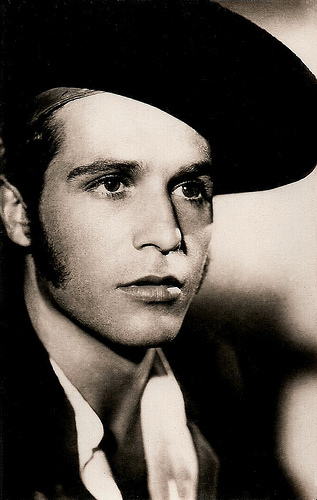
Vintage postcard.
Romantic Leads and Rogues
Francisco 'Paco' Rabal Valera was born in Águilas, a small mining community in the Spanish province of Murcia, in 1926. His father, Benito Rabal, worked in the mines while his mother, Teresa Valera, ran a mill. In 1936, after the Spanish Civil War broke out, the family left Murcia and moved to Madrid.
Young Francisco had to support his family as a street salesboy and a worker in a chocolate factory, while studying in the night time at the Colegio Nuestra Señora del Recuerdo. Later on he worked as assistant electrician at Estudios Chamartín, a film studio.
While working at the studio, Rabal became interested in acting and began taking onscreen work as a bit player. Dámaso Alonso and other people advised him to try his luck with a career in theatre. During the following years, he got some roles from theater companies such as Lope de Vega or María Guerrero.
It was there that he met actress Asunción Balaguer. They married and remained together for the rest of Rabal's life. Their daughter, Teresa Rabal, is also an actor, while his son Benito Rabal is a director.
In 1947, Rabal got some regular jobs in the theatre. He used his full name, Francisco Rabal, as stage name. However, the people who knew him always called him Paco (Paco being the familiar form for Francisco) and 'Paco Rabal' became his unofficial stage name.
During the 1940s, Rabal began to act in films as an extra. In 1942 he played his first bit part in La rueda de vida. Rabal joined the theater company Compañía de Isabel Garcés, and he participated at the editing of Diario íntimo de la tía Angélica (José María Pemán, 1946).
Gradually his parts increased. On stage, he obtained a big success in 1952 with his part in the Spanish version of Death of a Salesman by Arthur Miller. In 1946 he also had started to work as a supporting actor in such films as La pródiga/The Prodigal Woman (Rafael Gil, 1946).
It was not until 1950, however, that Rabal was first cast in speaking film roles. He played romantic leads and rogues in such films as La honradez de la cerradura/The honesty of the lock (Luis Escobar, 1950).
Rabal performed memorable stage parts on various occasions at the Festival de Teatro Romano at Mérida: in 1954 in Oedipus Rex, in 1955 in Julius Caesar, in 1956 Thyestes and in 1960 again in Oedipus, always under the direction of José Tamayo. But Rabal’s career moved more and more towards film.
His masculine good looks and easy charm quickly made him a popular leading man in Spain. In 1953 he received his first film award for La guerra de Dios/I Was a Parish Priest (Rafael Gil, 1953). The award was a Silver Lion at the Festival of Venice. That same year he won the award for best interpretation at the Festival of San Sebastián for Un camino a la derecha/There is a Path to the Right (Francisco Rovira Beleta, 1953), a crime drama about the black market set in a gritty Barcelona and its docks.
The following years he played in various successful films, including several leads in Italian films such as Prigionieri del male/Revelation (Mario Costa, 1955) with May Britt , La grande strada azzurra/The Big Blue Road (Gillo Pontecorvo, 1957) opposite Yves Montand , Marisa la civetta/Marisa (Mauro Bolognini, 1957) starring sexy Marisa Allasio , and the historical action drama Gerusalemme liberate/Jerusalem Liberated (Carlo Ludovico Bragaglia, 1957) with Sylva Koscina .
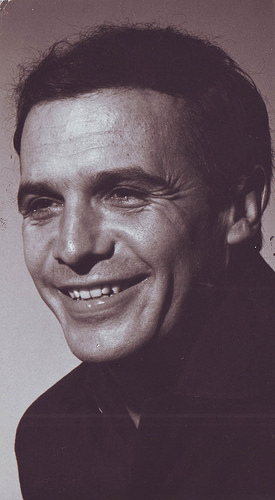
Spanish postcard. Collection: Manuel Palomino Arjona.
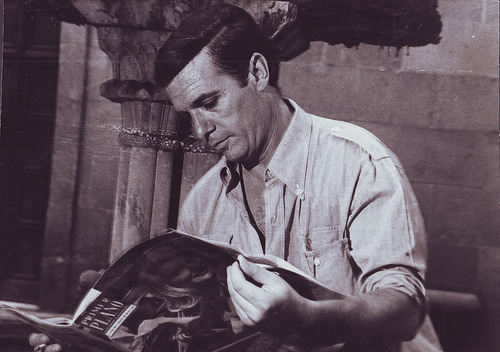
Spanish postcard. Photo: Wagner. Collection: Manuel Palomino Arjona.
Anticonventional Priest
In 1958 Francisco Rabal went to Mexico to play Father Nazario, an anticonventional priest who attempts to live a pure and honest life strictly according to Christian principles, in Luis Buñuel’s Nazarín (1959). Nazarín was Rabal’s definitive breakthrough as an international film actor. The two struck a long lasting friendship, and Rabal would star in three major films by Buñuel.
Rabal played another important role opposite Silvia Pinal and Fernando Rey in Viridiana (Luis Buñuel, 1961). The script was initially approved by the Spanish authorities with a few minor changes. They had no opportunity to view the finished film until it played at the Cannes Film Festival where it won the Grand Prix. Nevertheless theSpanish authorities were sufficiently horrified by what they saw to ban the film.
Rabal’s measured performance came from years of stage acting training. The role made him for decades one of the most important actors of the Spanish cinema. Another major role was that of the intellectual fiancé of Monica Vitti ’s Claudia in the Italian classic L’eclisse/Eclipse (Michelangelo Antonioni, 1962).
Interesting was also his part as the father confessor in La Religieuse/The Nun (Jacques Rivette, 1966), a faithful adaptation of a bitter attack on religious abuses by the Enlightenment philosopher Denis Diderot.
Rabal’s third film with Buñuel was Belle de jour (Luis Buñuel, 1967), starring Catherine Deneuve and Michel Piccoli . Rabal incarnated revolutionary Che Guevara in El 'Che' Guevara (Paolo Heuchs, 1968).
American director William Friedkin thought of Rabal for the role of the French villain in The French Connection (William Friedkin, 1971). However, he could not remember the name of 'that Spanish actor', and his staff hired by mistake another Spanish actor, Fernando Rey. Friedkin discovered that Rabal did not speak English or French, so he decided to keep Rey for the now legendary film. Later Rabal did work with Friedkin in the much less successful but Academy Award-nominated Sorcerer (William Friedkin, 1977), a remake of the cult classic Le salaire de la peur/The Wages of Fear (Henri-Georges Clouzot, 1953).
In Italy he appeared in Luchino Visconti's segment La strega bruciata viva/The Burnt Alive Witch of the anthology film Le Streghe/The Witches (1966) starring Silvana Mangano and Il deserto dei tartari/The Desert of the Tartars (Valerio Zurlini, 1976) with Jacques Perrin .
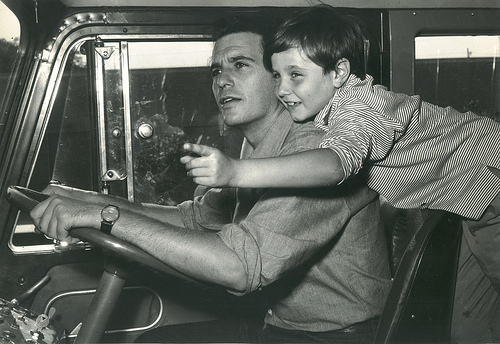
Spanish postcard. Photo: Bosio Press. Collection: Manuel Palomino Arjona.
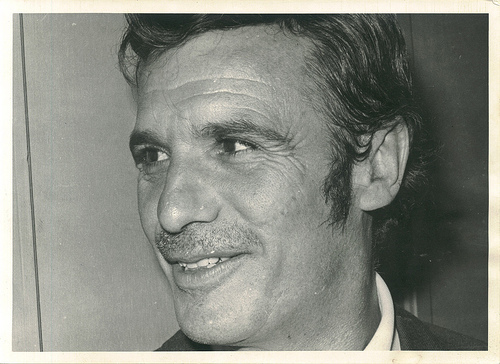
Spanish photo. Collection: Manuel Palomino Arjona.
An Old and Invalid Film Director
As Francisco Rabal grew older, his waist thickened and his hairline receded, but he seized the opportunity to play less glamorous and more challenging roles. It is even said that Rabal's best performances came after Francisco Franco's death on 1975. His performance as the old Azarías in Los santos inocentes/The Holy Innocents (Mario Camus, 1984) won him the Award as Best Actor at the 1984 Cannes Film Festival (ex aequo with his compatriot Alfredo Landa who featured in the same film).
Other memorable films in the 1980s were La colmena/The Beehive (Mario Camus, 1982) with Victoria Abril, and Camorra (Lina Wertmuller, 1984). In 1989, Rabal played an old and invalid film director in Almodovar’s Átame!/Tie Me Up, Tie Me Down! (Pedro Almodovar, 1989) starring Victoria Abril and Antonio Banderas .
On television, he played in Cervantes (Alfonso Ungría, 1981), the painter Francisco de Goya in the mini-series Los desastres de la guerra/The disasters of the war (Mario Camus, 1983), San Pedro de Alcántara in another miniseries Teresa de Jesús/St. Teresa of Avila (Josefina Molina, 1985), and he starred as the retired bullfighter Juncal in the exciting TV series Juncal (Jaime de Armiñán, 1989).
Rabal got many honours. In 1989, he was a member of the jury at the 39th Berlin International Film Festival. At the 1991 Montreal Film Festival he was named best Actor for L’Homme qui a perdu son ombre/The Man Who Lost His Shadow (Alain Tanner, 1991). In 1993 he received a gold medal from the Spanish film academy.
In 1999 he scored another late-career triumph with his acclaimed performance as the old Francisco Goya in Goya en Burdeos/Goya in Bordeaux (Carlos Saura, 1999). For this role he won the most prestigious Spanish film award, the Goya Award. And he is the only Spanish actor who received a honoris causa doctoral degree from the University of Murcia (1995).
Rabal's final film was the horror film Dagon (Stuart Gordon, 2001), based on short stories by H.P. Lovecraft. The film was dedicated to him: "Dedicated to Francisco Rabal, a wonderful actor and even better human being."
Rabal died in 2001 from compensatory dilating emphysema, while on an airplane travelling to Bordeaux, when he was coming back from receiving an Award at the Montreal Film Festival. One week later he was supposed to receive the Donostia Lifetime Achievement Award at the San Sebastian film festival.
His grandson, actor Liberto Rabal, accepted the honorary award on behalf of his grandfather, honoring his name in what was an emotional reunion of all Rabal’s old friends and colleagues. Throughout his career, Francisco Rabal had worked on more than 200 films in Spain, France, Italy, Hollywood and Mexico.
Trailer for Viridiana (1961). Source: Kinetoskop – Internetowy Magazyn Filmowy (YouTube).
Trailer for Sorcerer/Wages of Fear (1977). Source: Jonno 773 (YouTube).
Trailer Átame!/Tie Me Up, Tie Me Down! (1989). Source: The Cult Box (YouTube).
The original US Trailer from Dagon (2001). Source: Deathdealeus1984 (YouTube).
Sources: (IMDb), AllMovie, Encyclopædia Britannica, Wikipedia (English, Spanish, Italian and German), and .

Vintage postcard.
Romantic Leads and Rogues
Francisco 'Paco' Rabal Valera was born in Águilas, a small mining community in the Spanish province of Murcia, in 1926. His father, Benito Rabal, worked in the mines while his mother, Teresa Valera, ran a mill. In 1936, after the Spanish Civil War broke out, the family left Murcia and moved to Madrid.
Young Francisco had to support his family as a street salesboy and a worker in a chocolate factory, while studying in the night time at the Colegio Nuestra Señora del Recuerdo. Later on he worked as assistant electrician at Estudios Chamartín, a film studio.
While working at the studio, Rabal became interested in acting and began taking onscreen work as a bit player. Dámaso Alonso and other people advised him to try his luck with a career in theatre. During the following years, he got some roles from theater companies such as Lope de Vega or María Guerrero.
It was there that he met actress Asunción Balaguer. They married and remained together for the rest of Rabal's life. Their daughter, Teresa Rabal, is also an actor, while his son Benito Rabal is a director.
In 1947, Rabal got some regular jobs in the theatre. He used his full name, Francisco Rabal, as stage name. However, the people who knew him always called him Paco (Paco being the familiar form for Francisco) and 'Paco Rabal' became his unofficial stage name.
During the 1940s, Rabal began to act in films as an extra. In 1942 he played his first bit part in La rueda de vida. Rabal joined the theater company Compañía de Isabel Garcés, and he participated at the editing of Diario íntimo de la tía Angélica (José María Pemán, 1946).
Gradually his parts increased. On stage, he obtained a big success in 1952 with his part in the Spanish version of Death of a Salesman by Arthur Miller. In 1946 he also had started to work as a supporting actor in such films as La pródiga/The Prodigal Woman (Rafael Gil, 1946).
It was not until 1950, however, that Rabal was first cast in speaking film roles. He played romantic leads and rogues in such films as La honradez de la cerradura/The honesty of the lock (Luis Escobar, 1950).
Rabal performed memorable stage parts on various occasions at the Festival de Teatro Romano at Mérida: in 1954 in Oedipus Rex, in 1955 in Julius Caesar, in 1956 Thyestes and in 1960 again in Oedipus, always under the direction of José Tamayo. But Rabal’s career moved more and more towards film.
His masculine good looks and easy charm quickly made him a popular leading man in Spain. In 1953 he received his first film award for La guerra de Dios/I Was a Parish Priest (Rafael Gil, 1953). The award was a Silver Lion at the Festival of Venice. That same year he won the award for best interpretation at the Festival of San Sebastián for Un camino a la derecha/There is a Path to the Right (Francisco Rovira Beleta, 1953), a crime drama about the black market set in a gritty Barcelona and its docks.
The following years he played in various successful films, including several leads in Italian films such as Prigionieri del male/Revelation (Mario Costa, 1955) with May Britt , La grande strada azzurra/The Big Blue Road (Gillo Pontecorvo, 1957) opposite Yves Montand , Marisa la civetta/Marisa (Mauro Bolognini, 1957) starring sexy Marisa Allasio , and the historical action drama Gerusalemme liberate/Jerusalem Liberated (Carlo Ludovico Bragaglia, 1957) with Sylva Koscina .

Spanish postcard. Collection: Manuel Palomino Arjona.

Spanish postcard. Photo: Wagner. Collection: Manuel Palomino Arjona.
Anticonventional Priest
In 1958 Francisco Rabal went to Mexico to play Father Nazario, an anticonventional priest who attempts to live a pure and honest life strictly according to Christian principles, in Luis Buñuel’s Nazarín (1959). Nazarín was Rabal’s definitive breakthrough as an international film actor. The two struck a long lasting friendship, and Rabal would star in three major films by Buñuel.
Rabal played another important role opposite Silvia Pinal and Fernando Rey in Viridiana (Luis Buñuel, 1961). The script was initially approved by the Spanish authorities with a few minor changes. They had no opportunity to view the finished film until it played at the Cannes Film Festival where it won the Grand Prix. Nevertheless theSpanish authorities were sufficiently horrified by what they saw to ban the film.
Rabal’s measured performance came from years of stage acting training. The role made him for decades one of the most important actors of the Spanish cinema. Another major role was that of the intellectual fiancé of Monica Vitti ’s Claudia in the Italian classic L’eclisse/Eclipse (Michelangelo Antonioni, 1962).
Interesting was also his part as the father confessor in La Religieuse/The Nun (Jacques Rivette, 1966), a faithful adaptation of a bitter attack on religious abuses by the Enlightenment philosopher Denis Diderot.
Rabal’s third film with Buñuel was Belle de jour (Luis Buñuel, 1967), starring Catherine Deneuve and Michel Piccoli . Rabal incarnated revolutionary Che Guevara in El 'Che' Guevara (Paolo Heuchs, 1968).
American director William Friedkin thought of Rabal for the role of the French villain in The French Connection (William Friedkin, 1971). However, he could not remember the name of 'that Spanish actor', and his staff hired by mistake another Spanish actor, Fernando Rey. Friedkin discovered that Rabal did not speak English or French, so he decided to keep Rey for the now legendary film. Later Rabal did work with Friedkin in the much less successful but Academy Award-nominated Sorcerer (William Friedkin, 1977), a remake of the cult classic Le salaire de la peur/The Wages of Fear (Henri-Georges Clouzot, 1953).
In Italy he appeared in Luchino Visconti's segment La strega bruciata viva/The Burnt Alive Witch of the anthology film Le Streghe/The Witches (1966) starring Silvana Mangano and Il deserto dei tartari/The Desert of the Tartars (Valerio Zurlini, 1976) with Jacques Perrin .

Spanish postcard. Photo: Bosio Press. Collection: Manuel Palomino Arjona.

Spanish photo. Collection: Manuel Palomino Arjona.
An Old and Invalid Film Director
As Francisco Rabal grew older, his waist thickened and his hairline receded, but he seized the opportunity to play less glamorous and more challenging roles. It is even said that Rabal's best performances came after Francisco Franco's death on 1975. His performance as the old Azarías in Los santos inocentes/The Holy Innocents (Mario Camus, 1984) won him the Award as Best Actor at the 1984 Cannes Film Festival (ex aequo with his compatriot Alfredo Landa who featured in the same film).
Other memorable films in the 1980s were La colmena/The Beehive (Mario Camus, 1982) with Victoria Abril, and Camorra (Lina Wertmuller, 1984). In 1989, Rabal played an old and invalid film director in Almodovar’s Átame!/Tie Me Up, Tie Me Down! (Pedro Almodovar, 1989) starring Victoria Abril and Antonio Banderas .
On television, he played in Cervantes (Alfonso Ungría, 1981), the painter Francisco de Goya in the mini-series Los desastres de la guerra/The disasters of the war (Mario Camus, 1983), San Pedro de Alcántara in another miniseries Teresa de Jesús/St. Teresa of Avila (Josefina Molina, 1985), and he starred as the retired bullfighter Juncal in the exciting TV series Juncal (Jaime de Armiñán, 1989).
Rabal got many honours. In 1989, he was a member of the jury at the 39th Berlin International Film Festival. At the 1991 Montreal Film Festival he was named best Actor for L’Homme qui a perdu son ombre/The Man Who Lost His Shadow (Alain Tanner, 1991). In 1993 he received a gold medal from the Spanish film academy.
In 1999 he scored another late-career triumph with his acclaimed performance as the old Francisco Goya in Goya en Burdeos/Goya in Bordeaux (Carlos Saura, 1999). For this role he won the most prestigious Spanish film award, the Goya Award. And he is the only Spanish actor who received a honoris causa doctoral degree from the University of Murcia (1995).
Rabal's final film was the horror film Dagon (Stuart Gordon, 2001), based on short stories by H.P. Lovecraft. The film was dedicated to him: "Dedicated to Francisco Rabal, a wonderful actor and even better human being."
Rabal died in 2001 from compensatory dilating emphysema, while on an airplane travelling to Bordeaux, when he was coming back from receiving an Award at the Montreal Film Festival. One week later he was supposed to receive the Donostia Lifetime Achievement Award at the San Sebastian film festival.
His grandson, actor Liberto Rabal, accepted the honorary award on behalf of his grandfather, honoring his name in what was an emotional reunion of all Rabal’s old friends and colleagues. Throughout his career, Francisco Rabal had worked on more than 200 films in Spain, France, Italy, Hollywood and Mexico.
Trailer for Viridiana (1961). Source: Kinetoskop – Internetowy Magazyn Filmowy (YouTube).
Trailer for Sorcerer/Wages of Fear (1977). Source: Jonno 773 (YouTube).
Trailer Átame!/Tie Me Up, Tie Me Down! (1989). Source: The Cult Box (YouTube).
The original US Trailer from Dagon (2001). Source: Deathdealeus1984 (YouTube).
Sources: (IMDb), AllMovie, Encyclopædia Britannica, Wikipedia (English, Spanish, Italian and German), and .
Published on July 31, 2016 22:00
July 30, 2016
Werner Pittschau
Handsome actor Werner Pittschau (1902-1928) was the promising jeune premier of the silent Austrian cinema. Sadly he was killed in a road accident at the age of 26.
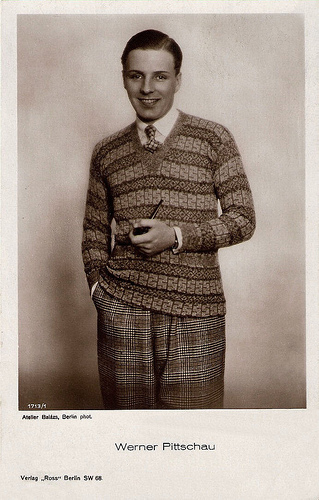
German postcard by Ross Verlag, no. 1713/1, 1927-1928 (sent by mail in the Netherlands in 1929). Photo: Atelier Balázs, Berlin.
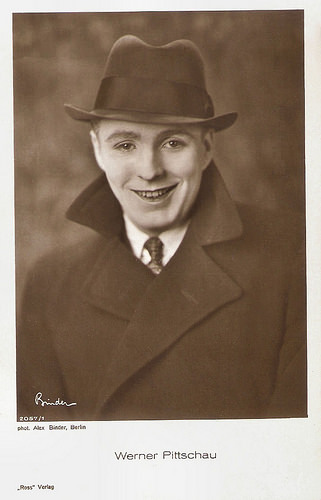
German postcard by Ross Verlag, no. 2057/1, 1927-1928. Photo: Alex Binder, Berlin.
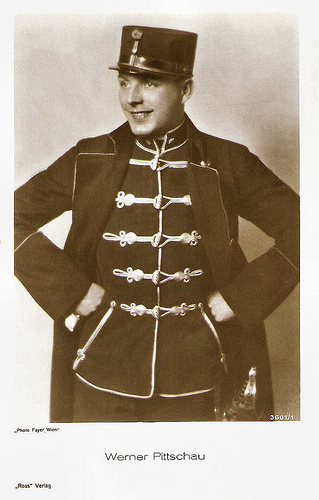
German postcard by Ross Verlag, no. 3601/1, 1928-1929. Photo: Fayer, Wien.
Acting Bug
Werner Pittschau was the son of Austrian stage actor Ernst Pittschau and stage actress Hilda Pittschau-Hofer née Schützenhofer. His older stepbrother Ernst Pittschau was a well-known film actor.
After his school education Werner went to a cadet school to become an officer. When the political situation in Austria changed he chose for a commercial education.
But the acting bug was inside him and he got his first engagement at the Landestheater in Prague as a jeune premier. There he was spotted by Erika Glässner and Hans Junkermann who brought him to the cinema.
He made his film début in the German film Der krasse Fuchs/The Cool Fox (Conrad Wiene, 1925) with Hans Brausewetter .
To his other early films belong Die Anne-Liese von Dessau (James Bauer, 1925) with Valy Arnheim, the war drama Volk in Not/Nation in Distress (Wolfgang Neff, 1925) with Claire Rommer , Die letzte Droschke von Berlin/The Last Taxi of Berlin (Carl Boese, 1926) and the German-British co-production Die versunkene Flotte/When Fleet Meets Fleet: A Romance of the Great Battle of Jutland (Graham Hewett, Manfred Noa, 1926), starring Hans Albers and Nils Asther .
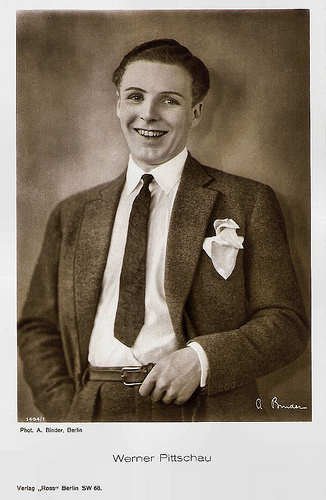
German postcard by Ross Verlag, no. 1494/1, 1927-1928. Photo: Alex Binder, Berlin.
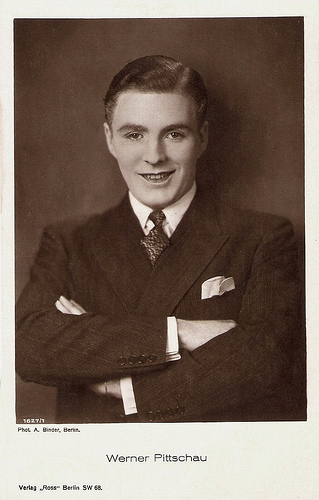
German postcard by Ross Verlag, no. 1627/1, 1927-1928. Photo: Alex Binder, Berlin.
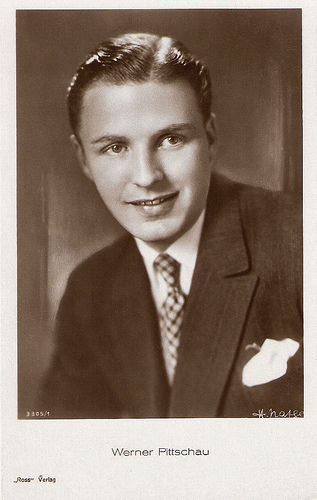
German postcard by Ross Verlag, no. 3305/1, 1928-1929. Photo: H. Natze.
Breakthrough
Werner Pittschau had a breakthrough in the box-office hit Dirnentragödie/Tragedy of the Street (Bruno Rahn, 1927) in which Asta Nielsen starred as a prostitute.
He continued this success with a starring role in the comedy Ehekonflikte/Wedding Wars (Bruno Rahn, 1927), Die Geliebte des Gouverneurs/The Prince and the Dancer (Friedrich Fehér, 1927) opposite Magda Sonja , and another successful role in Sacco und Vanzetti (Alfréd Deésy - also credited as Alfred Kempf-Dezsi, 1927).
In 1928 the busy young actor appeared in a.o. Tragödie im Zirkus Royal/Tragedy at the Royal Circus (Alfred Lind, 1928) starring Bernhard Goetzke , Die weisse Sonate/The White Sonata (Louis Seemann, 1928) with Carla Bartheel , and Der erste Kuss/The First Kiss (Carl Lamac, 1928) with Anny Ondra .
He also appeared in the Hungarian production Mária növér/Sister Maria (Antal Forgács, 1929) and the Czech-German coproduction Známosti z ulice/ Strassenbekanntschaften/Pick-ups (Josef Medeotti-Bohác, Alwin Neuß, 1929).
After Erzherzog Johann/Archduke Johann (Max Neufeld), 1929 with Xenia Desni his promising career ended abruptly.
On 28 November 1928 Werner Pittschau was killed in a road accident in Spandau. During his much too short career he had appeared in more than 20 films.
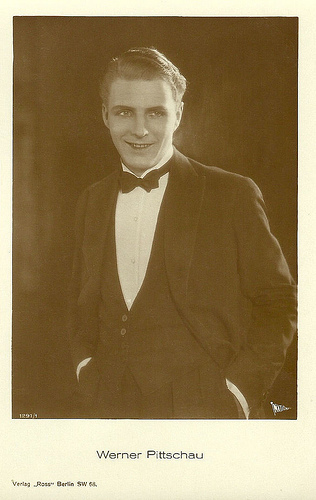
German postcard by Ross Verlag, no. 1291/1, 1927-1928. Photo: National. Collection: Didier Hanson.
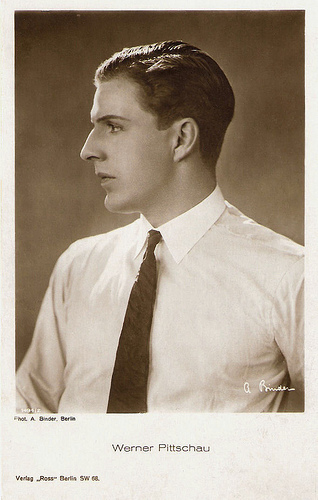
German postcard by Ross Verlag, no. 1494/2, 1927-1928. Photo: Alex Binder, Berlin.
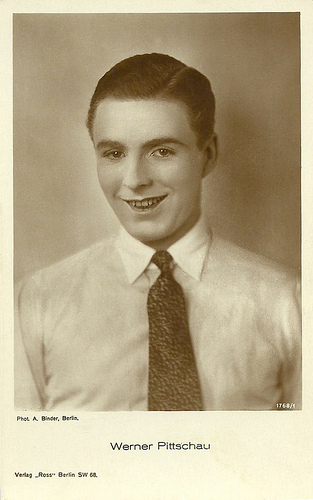
German postcard by Ross Verlag, no. 1768/1, 1927-1928. Photo: Alex Binder, Berlin. Collection: Didier Hanson.
Sources: Thomas Staedeli (Cyranos), Wikipedia (German), Filmportal.de, and .

German postcard by Ross Verlag, no. 1713/1, 1927-1928 (sent by mail in the Netherlands in 1929). Photo: Atelier Balázs, Berlin.

German postcard by Ross Verlag, no. 2057/1, 1927-1928. Photo: Alex Binder, Berlin.

German postcard by Ross Verlag, no. 3601/1, 1928-1929. Photo: Fayer, Wien.
Acting Bug
Werner Pittschau was the son of Austrian stage actor Ernst Pittschau and stage actress Hilda Pittschau-Hofer née Schützenhofer. His older stepbrother Ernst Pittschau was a well-known film actor.
After his school education Werner went to a cadet school to become an officer. When the political situation in Austria changed he chose for a commercial education.
But the acting bug was inside him and he got his first engagement at the Landestheater in Prague as a jeune premier. There he was spotted by Erika Glässner and Hans Junkermann who brought him to the cinema.
He made his film début in the German film Der krasse Fuchs/The Cool Fox (Conrad Wiene, 1925) with Hans Brausewetter .
To his other early films belong Die Anne-Liese von Dessau (James Bauer, 1925) with Valy Arnheim, the war drama Volk in Not/Nation in Distress (Wolfgang Neff, 1925) with Claire Rommer , Die letzte Droschke von Berlin/The Last Taxi of Berlin (Carl Boese, 1926) and the German-British co-production Die versunkene Flotte/When Fleet Meets Fleet: A Romance of the Great Battle of Jutland (Graham Hewett, Manfred Noa, 1926), starring Hans Albers and Nils Asther .

German postcard by Ross Verlag, no. 1494/1, 1927-1928. Photo: Alex Binder, Berlin.

German postcard by Ross Verlag, no. 1627/1, 1927-1928. Photo: Alex Binder, Berlin.

German postcard by Ross Verlag, no. 3305/1, 1928-1929. Photo: H. Natze.
Breakthrough
Werner Pittschau had a breakthrough in the box-office hit Dirnentragödie/Tragedy of the Street (Bruno Rahn, 1927) in which Asta Nielsen starred as a prostitute.
He continued this success with a starring role in the comedy Ehekonflikte/Wedding Wars (Bruno Rahn, 1927), Die Geliebte des Gouverneurs/The Prince and the Dancer (Friedrich Fehér, 1927) opposite Magda Sonja , and another successful role in Sacco und Vanzetti (Alfréd Deésy - also credited as Alfred Kempf-Dezsi, 1927).
In 1928 the busy young actor appeared in a.o. Tragödie im Zirkus Royal/Tragedy at the Royal Circus (Alfred Lind, 1928) starring Bernhard Goetzke , Die weisse Sonate/The White Sonata (Louis Seemann, 1928) with Carla Bartheel , and Der erste Kuss/The First Kiss (Carl Lamac, 1928) with Anny Ondra .
He also appeared in the Hungarian production Mária növér/Sister Maria (Antal Forgács, 1929) and the Czech-German coproduction Známosti z ulice/ Strassenbekanntschaften/Pick-ups (Josef Medeotti-Bohác, Alwin Neuß, 1929).
After Erzherzog Johann/Archduke Johann (Max Neufeld), 1929 with Xenia Desni his promising career ended abruptly.
On 28 November 1928 Werner Pittschau was killed in a road accident in Spandau. During his much too short career he had appeared in more than 20 films.

German postcard by Ross Verlag, no. 1291/1, 1927-1928. Photo: National. Collection: Didier Hanson.

German postcard by Ross Verlag, no. 1494/2, 1927-1928. Photo: Alex Binder, Berlin.

German postcard by Ross Verlag, no. 1768/1, 1927-1928. Photo: Alex Binder, Berlin. Collection: Didier Hanson.
Sources: Thomas Staedeli (Cyranos), Wikipedia (German), Filmportal.de, and .
Published on July 30, 2016 22:00
A word from the editor
July 2016 was an excellent month for EFSP. For the first time since May 2010 when we started counting, there were more than 90,000 pageviews in one month. So, what can I say?
Thanks!
Your views encourage me to continue this blog. But to be honest, EFSP is a product of many people, and I sincerely want to salute them - here and now.
First, a salute to the people who once created these film star postcards: the photographers, the publishers, and the stars. Happily for us, there were also the fans who collected and preserved all these - now - vintage cards.
Since we started this blog in 2008, many of you supported EFSP in one way or another. Some people have sent me postcards or other memorabilia to share here. Like Tatiana from the US who donated me postcards, photos and a clipping on the silent, Ukrainian-born film star Xenia Desni and her daughter Tamara Desni . Xenia and Tamara were Tatiana's aunt and niece.
A bittersweet memory is the mail by the partner of that glamorous British film star of the 1960s. He asked for a correction about her age: she was much younger than EFSP mentioned! All our sources were wrong, she had told it him herself! Of course, we respectfully skipped that post from EFSP.
I also salute our friends at Flickr, like Manuel, Veronique, Asa, Gill, Miss Mertens, Greta-g, etc., who were so generous to allow us to share their postcards in this blog.
Others of you shared information with me, commented and followed EFSP critically. We love that! A mystery to me is Erhanizzet . This anonymous film fan helped me to identify dozens of the film stills on our postcards, but never identified himself - or herself - to me and never answers my mails...
Thanks for being a source of information!
Doctor Macro at Doctor Macro's High Quality Movie Scans - who inspired me to scan pictures for the web for all to share.La belle équipe at L'encinemathèque .Philippe Pelletier at CinéArtistes .André Siscot and the other contributors at Les Gens du Cinema .Thomas Staedeli at Cyranos .Stephanie D'heil at Steffi-Line .Hal Erickson and all the other contributors at AllMovie .Brian J. Walker at Brian's Drive-in Theater .James Travers at Le Film Guide .David Absalom at British Pictures .Katherine Frances Nagels at Silents please! . Filmportal.de , Wikipedia and IMDb .And everyone who I forget to mention here.
Thanks for being a friend!
Didier Hanson, collector extraordinaire from Spain. Don't miss our post next Friday for some of his latest acquistions!Marlene Pilaete, 'La collectionneuse' from Belgium, editor of the web's most beautiful film postcard site.Egbert Barten of the Geoffrey Donaldson Institute . Check out our post about GDI's new acquisitions on 12 August.Bunched Undies, for the best film reviews and recipees on the web. Beth , keeper of the flame of Postcard Friendship Friday. Ivo Blom, my partner in life and in passion for film history.
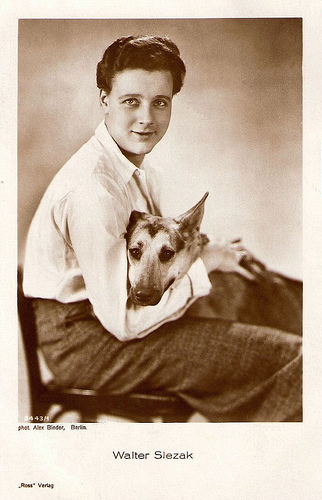
Greetings from Amsterdam!
Paul van Yperen a.k.a. Bob
Thanks!
Your views encourage me to continue this blog. But to be honest, EFSP is a product of many people, and I sincerely want to salute them - here and now.
First, a salute to the people who once created these film star postcards: the photographers, the publishers, and the stars. Happily for us, there were also the fans who collected and preserved all these - now - vintage cards.
Since we started this blog in 2008, many of you supported EFSP in one way or another. Some people have sent me postcards or other memorabilia to share here. Like Tatiana from the US who donated me postcards, photos and a clipping on the silent, Ukrainian-born film star Xenia Desni and her daughter Tamara Desni . Xenia and Tamara were Tatiana's aunt and niece.
A bittersweet memory is the mail by the partner of that glamorous British film star of the 1960s. He asked for a correction about her age: she was much younger than EFSP mentioned! All our sources were wrong, she had told it him herself! Of course, we respectfully skipped that post from EFSP.
I also salute our friends at Flickr, like Manuel, Veronique, Asa, Gill, Miss Mertens, Greta-g, etc., who were so generous to allow us to share their postcards in this blog.
Others of you shared information with me, commented and followed EFSP critically. We love that! A mystery to me is Erhanizzet . This anonymous film fan helped me to identify dozens of the film stills on our postcards, but never identified himself - or herself - to me and never answers my mails...
Thanks for being a source of information!
Doctor Macro at Doctor Macro's High Quality Movie Scans - who inspired me to scan pictures for the web for all to share.La belle équipe at L'encinemathèque .Philippe Pelletier at CinéArtistes .André Siscot and the other contributors at Les Gens du Cinema .Thomas Staedeli at Cyranos .Stephanie D'heil at Steffi-Line .Hal Erickson and all the other contributors at AllMovie .Brian J. Walker at Brian's Drive-in Theater .James Travers at Le Film Guide .David Absalom at British Pictures .Katherine Frances Nagels at Silents please! . Filmportal.de , Wikipedia and IMDb .And everyone who I forget to mention here.
Thanks for being a friend!
Didier Hanson, collector extraordinaire from Spain. Don't miss our post next Friday for some of his latest acquistions!Marlene Pilaete, 'La collectionneuse' from Belgium, editor of the web's most beautiful film postcard site.Egbert Barten of the Geoffrey Donaldson Institute . Check out our post about GDI's new acquisitions on 12 August.Bunched Undies, for the best film reviews and recipees on the web. Beth , keeper of the flame of Postcard Friendship Friday. Ivo Blom, my partner in life and in passion for film history.

Greetings from Amsterdam!
Paul van Yperen a.k.a. Bob
Published on July 30, 2016 14:59
July 29, 2016
Chrissie White
Blue-eyed and light-haired beauty Chrissie White (1895-1989) was one of the most famous stars of the British silent cinema. In 1907 the 12-years old started at the Hepworth company and soon became a popular child star. In the 1920s, she and husband Henry Edwards were regarded as one of Britain's most newsworthy celebrity couples.
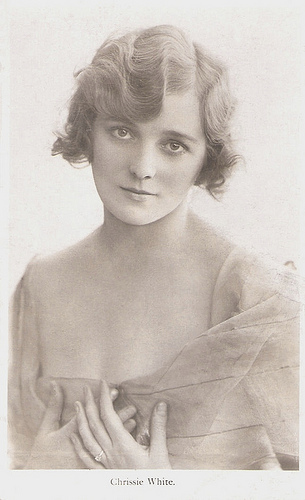
British postcard. Photo: Hepworth Pictures.
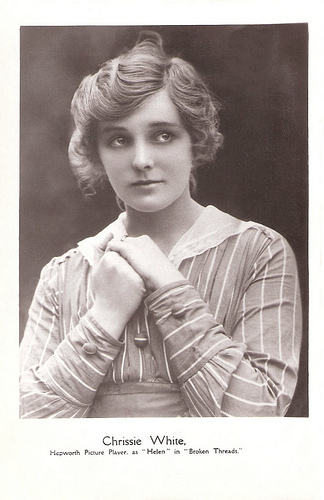
British postcard. Photo: Hepworth Pictures. Publicity still for Broken Threads (Henry Edwards, 1917).
Creating Havoc Everywhere
Chrissie White was born Ada Constance White in Chiswick, London, in 1895 – the year film was introduced by the Lumière brothers. As a child, she made her first stage appearance in Bluebell in Fairyland.
She started her film career when joining the Hepworth company in 1907, when she substituted for her sister, Gwen. Another sister, Rosina White also worked for Hepworth.
Ada was 12 at the time and under the name of ‘Chrissie’ she soon became one of the first stars of the British cinema. She often performed in shorts by director Lewin Fitzhamon, such as The Cabman's Good Fairy (Lewin Fitzhamon, 1909).
When White was teamed with Alma Taylor , they became a popular comic duo as the naughty schoolgirls Tilly (Taylor) and Sally (White), who create havoc everywhere.
The Tilly girls featured in a popular series of comedies in the years 1910 and 1911. Typical examples are Tilly the Tomboy Visits the Poor (Lewin Fitzhamon, 1910) and Tilly's Party (Lewin Fitzhamon, 1911). Although she was a star now, White always rode to the studios on a bicycle.
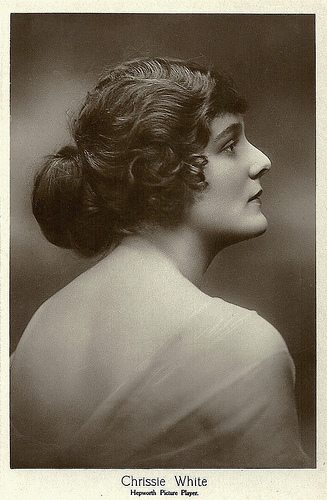
British postcard by Hepworth.
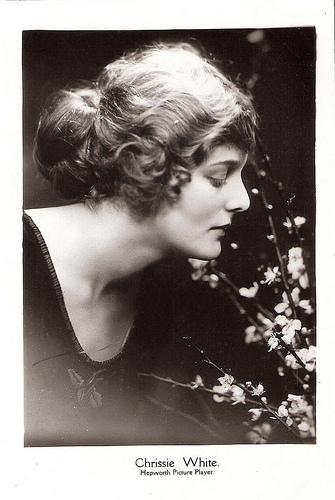
British postcard. Photo: Hepworth Pictures.
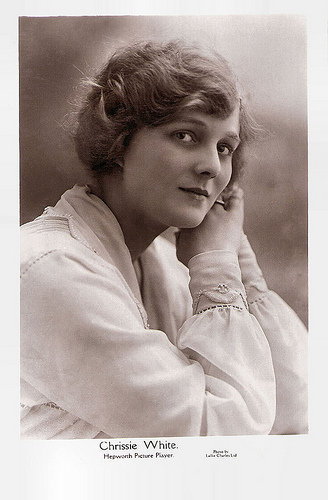
British postcard by Hepworth Pictures. Photo Lallie Charles.
Most Popular British Star of Her Time
Chrissie White moved slowly from comedy to drama and romance. By 1912 she had become Hepworth’s leading lady and the blue-eyed beauty was the most popular British star of her time. In the same year she married Claude Whitten, who also worked for Hepworth.
One of her earliest features was a crime film set in the horse racing milieu: Kissing Cup (1913, Jack Hulcup). This film still survives in the Desmet Collection at the Eye Film Institute in Amsterdam, as well as the Tilly comedy Tilly in a Boarding House (1911).
Other memorable titles were The Vicar of Wakefield (Frank Wilson, 1913) with Violet Hopson , and At the Foot of the Scaffold (1913, Warwick Buckland) opposite Alec Worcester.
Among Chrissie White’s other male film partners were Lionelle Howard (from 1914 on), Stewart Rome (between 1914-1917), a.o. in Coward! (1915, Frank Wilson) and Her Boy (Frank Wilson, 1915), and Henry Edwards (from 1918 on).
Edwards also directed most of their films together, such as Possession (Henry Edwards, 1919), The City of Beautiful Nonsense (Henry Edwards, 1919), The Kinsman (Henry Edwards, 1919), The Bargain (Henry Edwards, 1921) and Lily of the Alley (Henry Edwards, 1923).
All in all they did some 22 films together. They were also a couple in real life, as White married Edwards in 1922. Edwards and White became real celebrities in Britain, the equivalent of Douglas Fairbanks and Mary Pickford.
White's last silent film with Edwards was the romance The World of Wonderful Reality (Henry Edwards, 1924). When Hepworth collapsed in 1924, Chrissie White - who had worked only for Hepworth - retired from the screen, to the regret of her fans.
She returned briefly in the sound era to play in two more films with Edwards as her male partner: The Call of the Sea (Leslie Hiscott, 1930) and the comedy General John Regan (Henry Edwards, 1933), filmed in Northern Ireland. White definitively retired from the screen, and after the death of Edwards in 1952 she withdrew completely from publicity. She had worked in over 180 films, shorts and features.
At the age of 94, Chrissie White died of a heart attack in Liss, Hampshire, England, in 1989. She was buried at the Westwood Memorial Park. Actress Henryetta Edwards (1926) is her daughter. Clips of Chrissie White's films can be traced in the BBC / BFI documentary Silent Britain (2006).
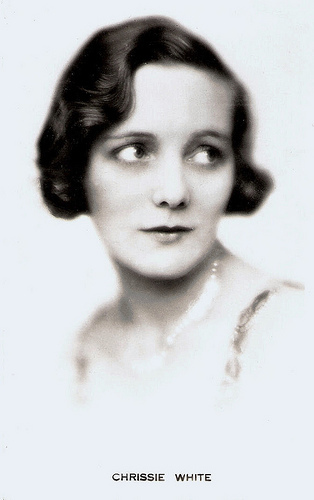
British postcard by T.I.C.
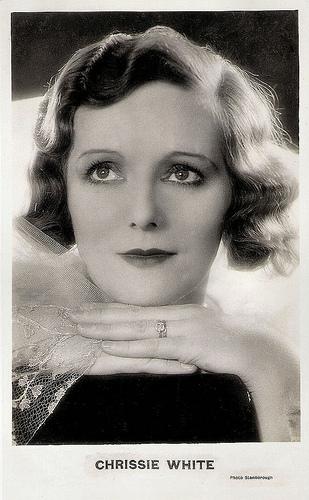
British postcard. Photo: Stanborough.
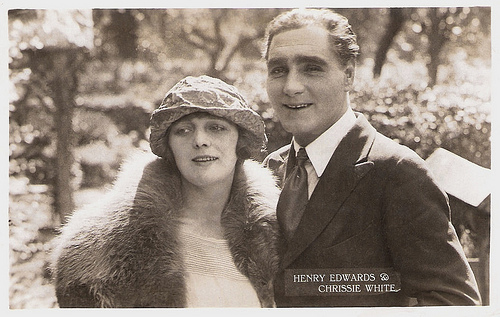
With Henry Edwards . British postcard by TIC.
Sources: (IMDb), Hepworthfilm.org, Wikipedia, and .

British postcard. Photo: Hepworth Pictures.

British postcard. Photo: Hepworth Pictures. Publicity still for Broken Threads (Henry Edwards, 1917).
Creating Havoc Everywhere
Chrissie White was born Ada Constance White in Chiswick, London, in 1895 – the year film was introduced by the Lumière brothers. As a child, she made her first stage appearance in Bluebell in Fairyland.
She started her film career when joining the Hepworth company in 1907, when she substituted for her sister, Gwen. Another sister, Rosina White also worked for Hepworth.
Ada was 12 at the time and under the name of ‘Chrissie’ she soon became one of the first stars of the British cinema. She often performed in shorts by director Lewin Fitzhamon, such as The Cabman's Good Fairy (Lewin Fitzhamon, 1909).
When White was teamed with Alma Taylor , they became a popular comic duo as the naughty schoolgirls Tilly (Taylor) and Sally (White), who create havoc everywhere.
The Tilly girls featured in a popular series of comedies in the years 1910 and 1911. Typical examples are Tilly the Tomboy Visits the Poor (Lewin Fitzhamon, 1910) and Tilly's Party (Lewin Fitzhamon, 1911). Although she was a star now, White always rode to the studios on a bicycle.

British postcard by Hepworth.

British postcard. Photo: Hepworth Pictures.

British postcard by Hepworth Pictures. Photo Lallie Charles.
Most Popular British Star of Her Time
Chrissie White moved slowly from comedy to drama and romance. By 1912 she had become Hepworth’s leading lady and the blue-eyed beauty was the most popular British star of her time. In the same year she married Claude Whitten, who also worked for Hepworth.
One of her earliest features was a crime film set in the horse racing milieu: Kissing Cup (1913, Jack Hulcup). This film still survives in the Desmet Collection at the Eye Film Institute in Amsterdam, as well as the Tilly comedy Tilly in a Boarding House (1911).
Other memorable titles were The Vicar of Wakefield (Frank Wilson, 1913) with Violet Hopson , and At the Foot of the Scaffold (1913, Warwick Buckland) opposite Alec Worcester.
Among Chrissie White’s other male film partners were Lionelle Howard (from 1914 on), Stewart Rome (between 1914-1917), a.o. in Coward! (1915, Frank Wilson) and Her Boy (Frank Wilson, 1915), and Henry Edwards (from 1918 on).
Edwards also directed most of their films together, such as Possession (Henry Edwards, 1919), The City of Beautiful Nonsense (Henry Edwards, 1919), The Kinsman (Henry Edwards, 1919), The Bargain (Henry Edwards, 1921) and Lily of the Alley (Henry Edwards, 1923).
All in all they did some 22 films together. They were also a couple in real life, as White married Edwards in 1922. Edwards and White became real celebrities in Britain, the equivalent of Douglas Fairbanks and Mary Pickford.
White's last silent film with Edwards was the romance The World of Wonderful Reality (Henry Edwards, 1924). When Hepworth collapsed in 1924, Chrissie White - who had worked only for Hepworth - retired from the screen, to the regret of her fans.
She returned briefly in the sound era to play in two more films with Edwards as her male partner: The Call of the Sea (Leslie Hiscott, 1930) and the comedy General John Regan (Henry Edwards, 1933), filmed in Northern Ireland. White definitively retired from the screen, and after the death of Edwards in 1952 she withdrew completely from publicity. She had worked in over 180 films, shorts and features.
At the age of 94, Chrissie White died of a heart attack in Liss, Hampshire, England, in 1989. She was buried at the Westwood Memorial Park. Actress Henryetta Edwards (1926) is her daughter. Clips of Chrissie White's films can be traced in the BBC / BFI documentary Silent Britain (2006).

British postcard by T.I.C.

British postcard. Photo: Stanborough.

With Henry Edwards . British postcard by TIC.
Sources: (IMDb), Hepworthfilm.org, Wikipedia, and .
Published on July 29, 2016 22:00
July 28, 2016
EFSP's Dazzling Dozen: The Swedish Silent Cinema
My partner, Ivo Blom, recently visited Sweden and he found in a Stockholm shop 70 rare vintage postcards of Swedish silent films. Ivo selected twelve dazzling postcards for us today. In beautiful sepia tones, these cards give an impression of how the Scandinavian directors Victor Sjöström and Mauritz Stiller ruled the world cinema during the 1910s and 1920s. And then both were lured to Hollywood.
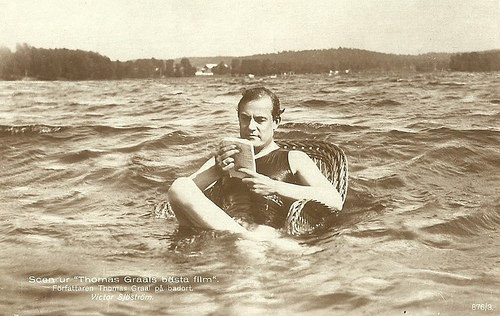
Swedish postcard by Ed. Nordisk Konst, Stockholm, no. 876/3. Photo: Svenska Biografteatern. Publicity still for the comedy Thomas Graals bästa film/Thomas Graal's Best Film (Mauritz Stiller, 1917), scripted by Gustav Molander. The story deals with a screenwriter ( Victor Sjöström ) who falls in love with his secretary Bessie ( Karin Molander ) and imagines himself rescuing her from poverty. Reality is quite different as Bessie is a modern woman. The film also mocks the bored aristocracy involved in the modernity of filmmaking. Caption: The author Thomas Graal at sea.
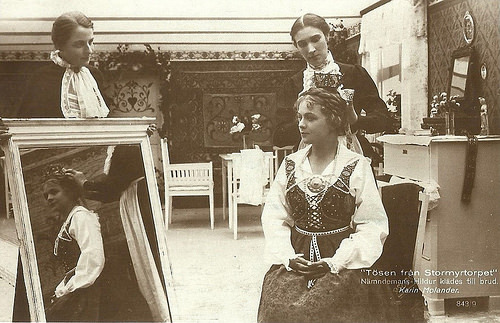
Swedish postcard by Nordisk Konst, Stockholm, no. 843. Photo: Svenska Biografteatern. Publicity still for Tösen från Stormyrtorpet/The Girl from the Marsh Croft (Victor Sjöström, 1917), after the novel of Selma Lagerlöf. Story: Gudmund ( Lars Hanson ) is about to marry Hildur ( Karin Molander ). Suddenly, the girl Helga (Greta Almroth) claims that Gudmund is the father of her baby. The case is brough to court. Caption: Hildur dressed up as bride.
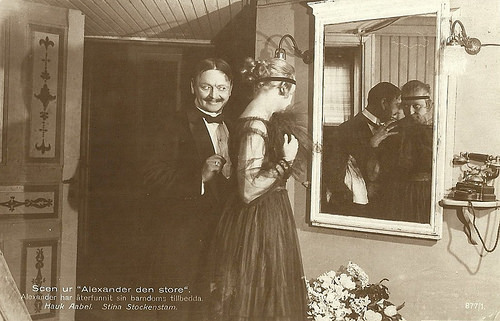
Swedish postcard by Nordisk Konst, Stockholm, no. 877/1. Photo: Svenska Biografteatern. Publicity still for the comedy Alexander den Store/Alexander the Great (Mauritz Stiller, 1917). The story of the film deals with a provincial hotel cook, named Alexander the Great (Hauk Abel), in whose restaurant not only the dishes can be spicy. Caption: Alexander has rediscovered his beloved from his youth (Stina Stockenstam).
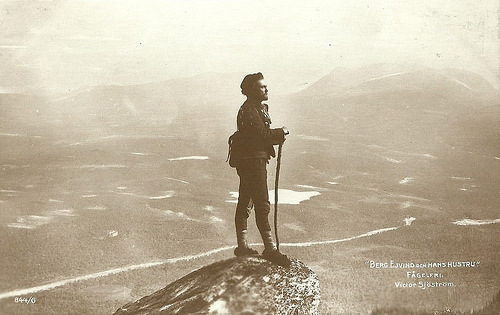
Swedish postcard by Nordisk Konst, Stockholm, no. 844/6. Photo: Svenska Biografteatern. Publicity still for Berg-Ejvind och hans hustru/The Outlaw and His Wife (Victor Sjöström, 1918). A stranger ( Victor Sjöström ) comes to work at the farm of widow Halla (Edith Erastoff). Halla and the stranger fall in love, but when he is revealed as Eyvind, an escaped thief forced into crime by his family's starvation, they flee and become two of the many outlaws of Iceland's mountains. The Outlaw and His Wife is one of the classics of Swedish silent cinema, shot in the mountains in North Sweden, and showing not only the hardship of nature but also the intolerance of humans. Caption: The Outlaw.
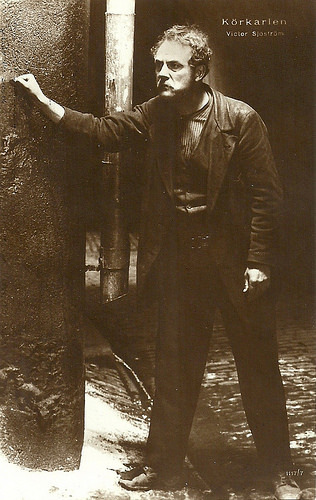
Swedish postcard by Ed. Nordisk Konst, Stockholm, no. 1117/7. Photo: Svensk Filmindustri. Publicity still for Körkarlen/The Phantom Carriage (Victor Sjöström, 1920). As he is the last one to die on New Year's Eve, the drunkard David Holm ( Victor Sjöström ) is forced to take over the phantom carriage for a full year, collecting the souls of the dead. Körkarlen is a classic from Swedish silent cinema.
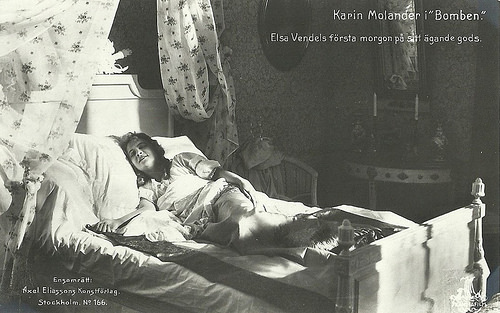
Swedish postcard by Ed. Axel Eliassons Konstförlag, Stockholm, no. 166. Photo: Skandia Film. Publicity still for Bomben/The Bomb (Rune Carlsten, 1920), starring Karin Molander . Caption: Elsa Vendel's first morning amidst her own possessions.
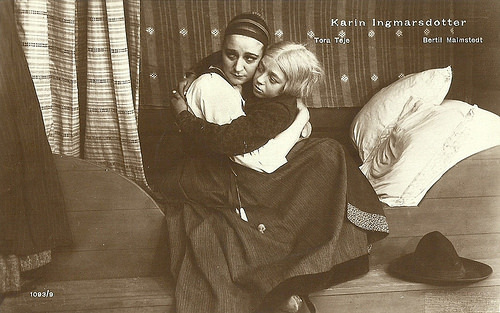
Swedish postcard by Nordisk Konst, Stockholm, no. 1093/9. Photo: Svenska Biografteatren. Publicity still for Karin Ingmarsdotter/God's Way/ Karin Daughter of Ingmar (Victor Sjöström, 1920), starring Tora Teje ; here with Bertil Malmstedt as her son.
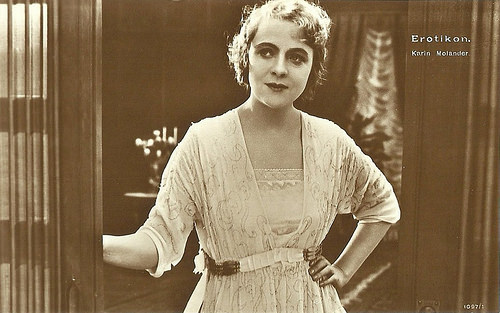
Swedish postcard by Nordisk Konst, Stockholm, no. 1097/1. Photo: Svensk Filmindustri. Publicity still for Erotikon/Bounds That Chafe (Mauritz Stiller, 1920), starring Karin Molander ; and not pictured here Anders de Wahl, Lars Hanson and Tora Teje .
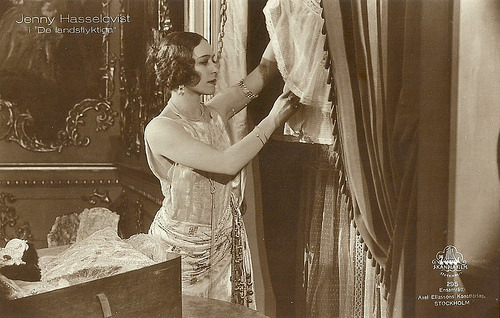
Swedish postcard by Ed. Axel Eliassons Konstförlag, Stockholm, no. 295. Photo: Skandia Film, Stockholm/Svensk Filmindustri. Publicity still for De landsflyktiga/The Emigrants/The Exiles (Mauritz Stiller, 1921), starring Jenny Hasselquist . This is a lost film, except for a few very short fragments.
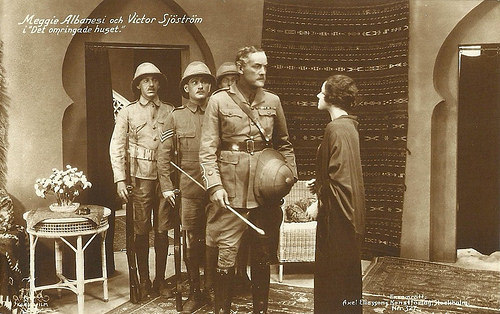
Swedish postcard by Ed. Axel Eliassons Konstförlag, Stockholm, no. 327. Photo: Skandia Film/Svensk Filminspelning. Publicity still for Det omringade huset/The Surrounded House (Victor Sjöström, 1922), starring Meggie Albanesi and Victor Sjöström .
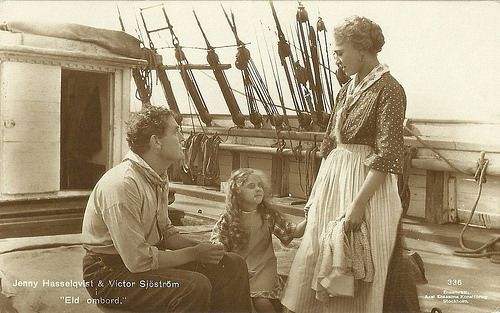
Swedish postcard by Ed. Axel Eliassons Konstförlag, Stockholm, no. 336. Photo: Svensk Filminspelning. Publicity still for Eld ombord/Fire on board (Victor Sjöström, 1923), starring Victor Sjöström and Jenny Hasselquist .
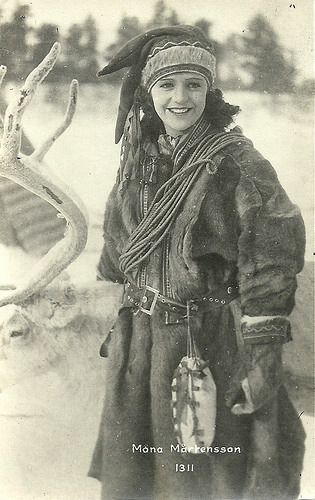
Finnish postcard by Kerttikeskus Kortcentralen, Helsinki, no. 1311. Photo: publicity still for the Swedish silent film Laila (George Schnéevoigt 1929), starring Mona Mårtenson aka Mona Mårtensson.
This is a post for Postcard Friendship Friday, hosted by Beth at the The Best Hearts are Crunchy. You can visit her by clicking on the button below.


Swedish postcard by Ed. Nordisk Konst, Stockholm, no. 876/3. Photo: Svenska Biografteatern. Publicity still for the comedy Thomas Graals bästa film/Thomas Graal's Best Film (Mauritz Stiller, 1917), scripted by Gustav Molander. The story deals with a screenwriter ( Victor Sjöström ) who falls in love with his secretary Bessie ( Karin Molander ) and imagines himself rescuing her from poverty. Reality is quite different as Bessie is a modern woman. The film also mocks the bored aristocracy involved in the modernity of filmmaking. Caption: The author Thomas Graal at sea.

Swedish postcard by Nordisk Konst, Stockholm, no. 843. Photo: Svenska Biografteatern. Publicity still for Tösen från Stormyrtorpet/The Girl from the Marsh Croft (Victor Sjöström, 1917), after the novel of Selma Lagerlöf. Story: Gudmund ( Lars Hanson ) is about to marry Hildur ( Karin Molander ). Suddenly, the girl Helga (Greta Almroth) claims that Gudmund is the father of her baby. The case is brough to court. Caption: Hildur dressed up as bride.

Swedish postcard by Nordisk Konst, Stockholm, no. 877/1. Photo: Svenska Biografteatern. Publicity still for the comedy Alexander den Store/Alexander the Great (Mauritz Stiller, 1917). The story of the film deals with a provincial hotel cook, named Alexander the Great (Hauk Abel), in whose restaurant not only the dishes can be spicy. Caption: Alexander has rediscovered his beloved from his youth (Stina Stockenstam).

Swedish postcard by Nordisk Konst, Stockholm, no. 844/6. Photo: Svenska Biografteatern. Publicity still for Berg-Ejvind och hans hustru/The Outlaw and His Wife (Victor Sjöström, 1918). A stranger ( Victor Sjöström ) comes to work at the farm of widow Halla (Edith Erastoff). Halla and the stranger fall in love, but when he is revealed as Eyvind, an escaped thief forced into crime by his family's starvation, they flee and become two of the many outlaws of Iceland's mountains. The Outlaw and His Wife is one of the classics of Swedish silent cinema, shot in the mountains in North Sweden, and showing not only the hardship of nature but also the intolerance of humans. Caption: The Outlaw.

Swedish postcard by Ed. Nordisk Konst, Stockholm, no. 1117/7. Photo: Svensk Filmindustri. Publicity still for Körkarlen/The Phantom Carriage (Victor Sjöström, 1920). As he is the last one to die on New Year's Eve, the drunkard David Holm ( Victor Sjöström ) is forced to take over the phantom carriage for a full year, collecting the souls of the dead. Körkarlen is a classic from Swedish silent cinema.

Swedish postcard by Ed. Axel Eliassons Konstförlag, Stockholm, no. 166. Photo: Skandia Film. Publicity still for Bomben/The Bomb (Rune Carlsten, 1920), starring Karin Molander . Caption: Elsa Vendel's first morning amidst her own possessions.

Swedish postcard by Nordisk Konst, Stockholm, no. 1093/9. Photo: Svenska Biografteatren. Publicity still for Karin Ingmarsdotter/God's Way/ Karin Daughter of Ingmar (Victor Sjöström, 1920), starring Tora Teje ; here with Bertil Malmstedt as her son.

Swedish postcard by Nordisk Konst, Stockholm, no. 1097/1. Photo: Svensk Filmindustri. Publicity still for Erotikon/Bounds That Chafe (Mauritz Stiller, 1920), starring Karin Molander ; and not pictured here Anders de Wahl, Lars Hanson and Tora Teje .

Swedish postcard by Ed. Axel Eliassons Konstförlag, Stockholm, no. 295. Photo: Skandia Film, Stockholm/Svensk Filmindustri. Publicity still for De landsflyktiga/The Emigrants/The Exiles (Mauritz Stiller, 1921), starring Jenny Hasselquist . This is a lost film, except for a few very short fragments.

Swedish postcard by Ed. Axel Eliassons Konstförlag, Stockholm, no. 327. Photo: Skandia Film/Svensk Filminspelning. Publicity still for Det omringade huset/The Surrounded House (Victor Sjöström, 1922), starring Meggie Albanesi and Victor Sjöström .

Swedish postcard by Ed. Axel Eliassons Konstförlag, Stockholm, no. 336. Photo: Svensk Filminspelning. Publicity still for Eld ombord/Fire on board (Victor Sjöström, 1923), starring Victor Sjöström and Jenny Hasselquist .

Finnish postcard by Kerttikeskus Kortcentralen, Helsinki, no. 1311. Photo: publicity still for the Swedish silent film Laila (George Schnéevoigt 1929), starring Mona Mårtenson aka Mona Mårtensson.
This is a post for Postcard Friendship Friday, hosted by Beth at the The Best Hearts are Crunchy. You can visit her by clicking on the button below.

Published on July 28, 2016 22:00
July 27, 2016
Assia Noris
Fresh and charming Assia Noris (1912-1998) is best remembered as the star of several 1930s romantic comedies directed by Mario Camerini and co-starring Vittorio De Sica. Although Russian-born, she was nicknamed Italy's sweetheart.
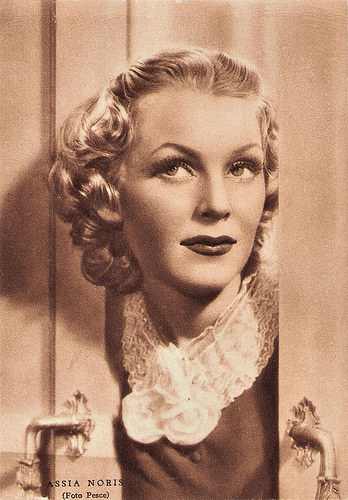
Italian postcard by Rizzoli EC., Milano, 1938-XVI. Photo: Pesce.
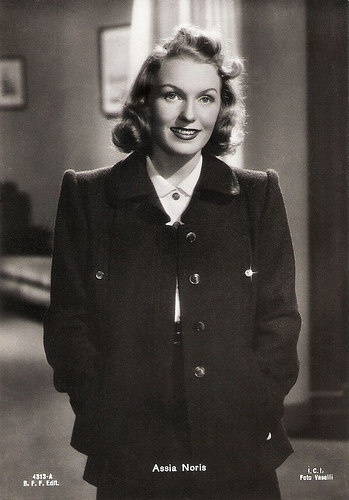
Italian postcard by B.F.F. Edit, no. 413-A. Photo: I.C.I. / Vaselli.
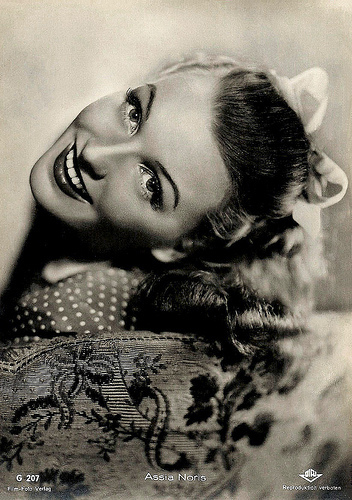
German postcard by Film-Foto-Verlag, no. G 207, 1941-1944. Photo: Difu.
Five Husbands
Assia Noris was born Anastasia Noris von Gerzfeld in St. Petersburg, Russia, in 1912. Her father was a German official, her mother was from Ukraine.
After the Russian Revolution the family fled first to France, then to Italy in 1929. That year Assia also married count Gastone d’Assia, whose last name she would use as stage name, even if he was only the first of her five husbands.
In 1933 Assia Noris made her screen début in Tre uomini in frac/I Sing for You Alone, the Italian version of the French film Trois hommes en habit. Both versions were directed by Mario Bonnard and starred opera singer Tito Schipa.
In 1935-1936 she also played in both the French and the Italian version of Bonnard’s La marcia nuziale/La marche nuptiale (Mario Bonnard, 1936).
Noris’ fame, however, is linked to her performances in the comedies by Mario Camerini, with whom she had an affair from 1936 on, dropping her former lover Roberto Rossellini – whom she presumably married for a very short time. At that time Rossellini was a penniless playboy and working as an editor, Camerini was an acclaimed director.
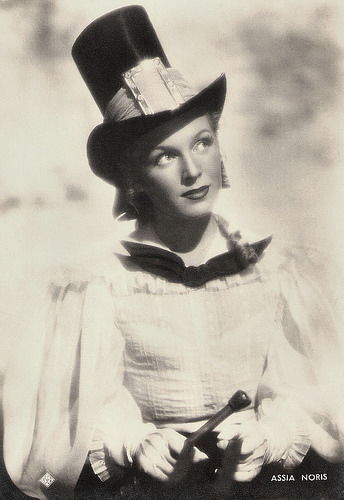
Italian postcard by A. Scarmiglia Ed., Roma (ASER), no. 166. Photo: Vaselli.
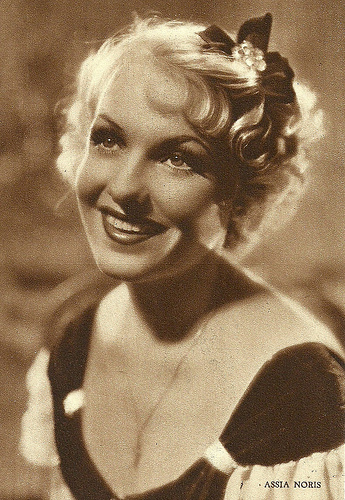
Italian postcard by Ed. Rizzoli, Milano, 1936.
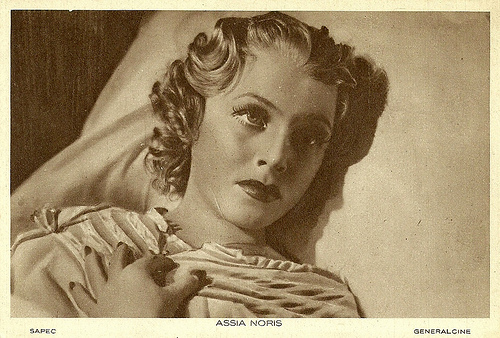
Italian postcard. Photo: SAPEC / Generalcine. Assia Noris in Voglio vivere con Letizia (Camillo Mastrocinque, 1938).
Angelic Looks
Assia Noris’ male co-partner in the Camerini comedies was heartthrob Vittorio De Sica . Often she played the honest lower or middle class girl, such as the circus girl Anna who has an affair with a millionaire who goes undercover as a bum in Darò un milione/I'll Give a Million (Mario Camerini, 1935)
Noris played the governess Lauretta who likes the newspaper vendor Gianni but dislikes the snob Max, not knowing they are one and the same man in Il signor Max/Mister Max (Mario Camerini, 1937). She is also the shopping girl in a department store who first dislikes, then falls in love with the new assistant and chauffeur, who becomes a local hero, in I Grandi magazzini/Department Store (Mario Camerini, 1939).
In all of these films De Sica pretends to be somebody else: a simple man while being millionnaire in Darò un milione, a millionaire while being a simple man in Il signor Max, while Assia Noris remains the honest, simple girl.
This pretense of a second character Noris played herself too in Batticuore/Heartbeat (Mario Camerini, 1939), in which she is a pickpocketing girl hired by a diplomat (John Lodge) but considered a baroness by others. She also played one and the same person but in three different stages of her life in Camerini’s Una romantica avventura/A Romantic Adventure (Mario Camerini, 1940) opposite Gino Cervi .
Guy Bellinger describes her star persona at IMDb : "Fresh and charming, she drew lots of fans into theaters. Not that the comedies she played in were masterpieces: they were in fact harmless and a bit artificial but constituted welcome escapism from the strange times the Italians were living. Not that Assia Noris was the greatest actress ever either: she never really changed face expressions, when she was supposed to cry she shed crocodile tears plus she could not go beyond the superficiality of the characters she was given to play. But how sizzling she was, how cute she was and what beautiful costumes and hats she wore!"
Noris demonstrated she could play the diva part as well in the comedy Dora Nelson (Mario Soldati, 1939), in which she really plays two characters opposite Carlo Ninchi: a bitchy Russian film star and as a simple girl replacing the impossible star, both at the Cinecittà studios as well as at home. Likeness causes problems but also offers attractive solutions.
During the war years Noris was a bit fed up with playing the ‘ingénue’, the fiancée; so she now also played dramatic roles as in Un colpo di pistola/A Pistol Shot (Renato Castellani, 1942) with Fosco Giachetti , and Una storia d’amore/Love Story (Mario Camerini, 1942) with Piero Lulli. With her romanticism and her angelic looks, she represented the Italian woman ‘par excellence’ for over a decade, despite her overacting, her foreign accent and her rather Northern European beauty.
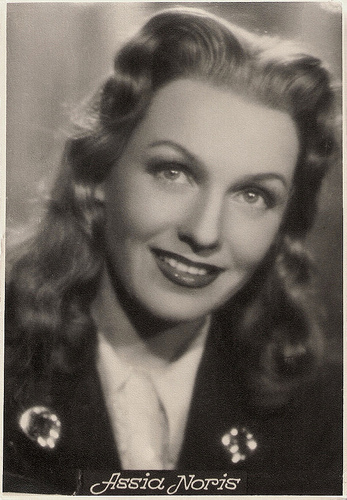
Italian postcard by Mimosa.
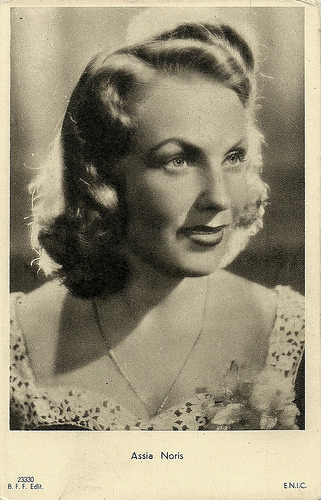
Italian postcard by B.F.F. Edit (Ballerini & Fratini Editori, Firenze), no. 2333. Photo: E.N.I.C.
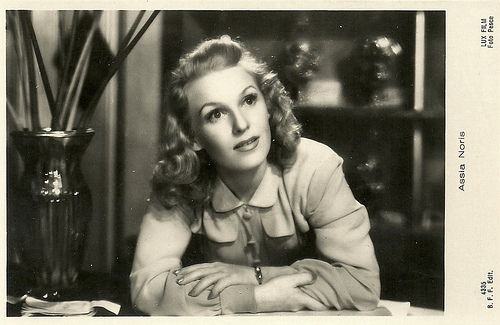
Italian postcard by B.F.F. Edit (Ballerini & Fratini Editori, Firenze), no. 4335. Photo: Lux Film / Foto Pesce.
Scandalous Bikini
Assia Noris was not a bit afraid to cause a scandal, being the first woman in Italy to wear a bikini in public, to great jealousy of rival actresses Doris Duranti and Clara Calamai .
One of her key moments in life was her encounter with Adolph Hitler, whom she described as a snowman with fake nose, eyes and moustache. While spitting her in the face, Hitler offered her to play at Ufa, which she gently declined, causing general embarrassment.
When war came on in 1940, Noris secured herself against her foreignness by marrying Mario Camerini, Italianizing her. The marriage ended in quarrels, though, in 1943.
Noris tried her luck in France with two films, Le voyageur de la Toussaint/The Traveller of All Saints' Day (Louis Daquin, 1943) with Jules Berry, and Le capitaine Fracasse/Captain Fracasse (Abel Gance, 1943) featuring Fernand Gravey , but both were unsuccessful.
When the war was over, Noris’ career was over as well. People did not blame her for her career under Benito Mussolini; her anti-fascism was known, but her type was traded now for the more populist face of Anna Magnani and of course those of the non-professional actors and actresses of the Neorealist cinema.
Noris did two more films in 1945, and one in 1951, but none were successes. She tried her luck on stage but this wasn’t a success as well. In 1961 film director Carlo Lizzani gave her one last lead in his comedy La Celestina P... R... (Carlo Lizzani, 1965) with Venantino Venantini.
For years Noris lived in Egypt with her fifth husband, the Egyptian impresario Antoine 'Tony' Habib – he came after D’Assia, Rosselini, Camerini, and the British official Jacob Pelster.
In 1998 Assia Noris died in a hospital in San Remo, Italy, after a short illness.
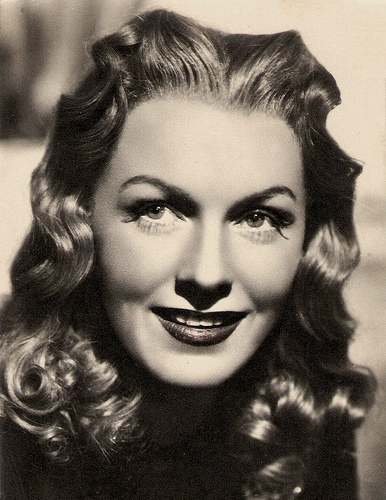
Italian postcard by A. Scarmiglia Ed., Roma (ASER), no. 43. Photo: Vaselli / Juventus.
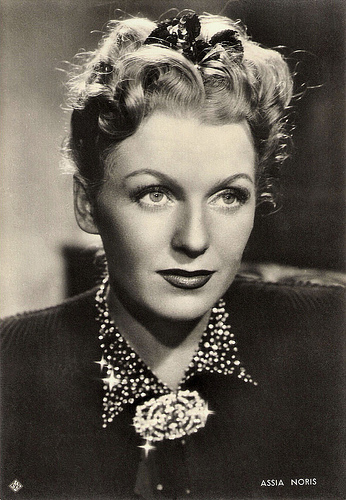
Italian postcard by A. Scarmiglia Ed., Roma (ASER), no. 111.
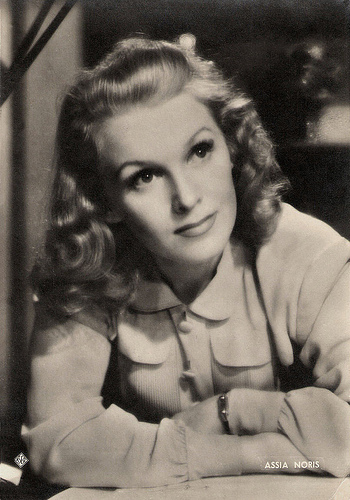
Italian postcard by A. Scarmiglia Ed., Roma (ASER), no. 222. Photo: Pesce / Lux Film.
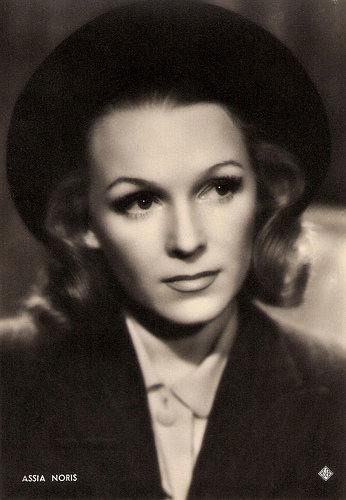
Italian postcard by A. Scarmiglia Ed., Roma (ASER), no. 237.
Sources: (IMDb), CineArtistes (French), Wikipedia (Italian), and .

Italian postcard by Rizzoli EC., Milano, 1938-XVI. Photo: Pesce.

Italian postcard by B.F.F. Edit, no. 413-A. Photo: I.C.I. / Vaselli.

German postcard by Film-Foto-Verlag, no. G 207, 1941-1944. Photo: Difu.
Five Husbands
Assia Noris was born Anastasia Noris von Gerzfeld in St. Petersburg, Russia, in 1912. Her father was a German official, her mother was from Ukraine.
After the Russian Revolution the family fled first to France, then to Italy in 1929. That year Assia also married count Gastone d’Assia, whose last name she would use as stage name, even if he was only the first of her five husbands.
In 1933 Assia Noris made her screen début in Tre uomini in frac/I Sing for You Alone, the Italian version of the French film Trois hommes en habit. Both versions were directed by Mario Bonnard and starred opera singer Tito Schipa.
In 1935-1936 she also played in both the French and the Italian version of Bonnard’s La marcia nuziale/La marche nuptiale (Mario Bonnard, 1936).
Noris’ fame, however, is linked to her performances in the comedies by Mario Camerini, with whom she had an affair from 1936 on, dropping her former lover Roberto Rossellini – whom she presumably married for a very short time. At that time Rossellini was a penniless playboy and working as an editor, Camerini was an acclaimed director.

Italian postcard by A. Scarmiglia Ed., Roma (ASER), no. 166. Photo: Vaselli.

Italian postcard by Ed. Rizzoli, Milano, 1936.

Italian postcard. Photo: SAPEC / Generalcine. Assia Noris in Voglio vivere con Letizia (Camillo Mastrocinque, 1938).
Angelic Looks
Assia Noris’ male co-partner in the Camerini comedies was heartthrob Vittorio De Sica . Often she played the honest lower or middle class girl, such as the circus girl Anna who has an affair with a millionaire who goes undercover as a bum in Darò un milione/I'll Give a Million (Mario Camerini, 1935)
Noris played the governess Lauretta who likes the newspaper vendor Gianni but dislikes the snob Max, not knowing they are one and the same man in Il signor Max/Mister Max (Mario Camerini, 1937). She is also the shopping girl in a department store who first dislikes, then falls in love with the new assistant and chauffeur, who becomes a local hero, in I Grandi magazzini/Department Store (Mario Camerini, 1939).
In all of these films De Sica pretends to be somebody else: a simple man while being millionnaire in Darò un milione, a millionaire while being a simple man in Il signor Max, while Assia Noris remains the honest, simple girl.
This pretense of a second character Noris played herself too in Batticuore/Heartbeat (Mario Camerini, 1939), in which she is a pickpocketing girl hired by a diplomat (John Lodge) but considered a baroness by others. She also played one and the same person but in three different stages of her life in Camerini’s Una romantica avventura/A Romantic Adventure (Mario Camerini, 1940) opposite Gino Cervi .
Guy Bellinger describes her star persona at IMDb : "Fresh and charming, she drew lots of fans into theaters. Not that the comedies she played in were masterpieces: they were in fact harmless and a bit artificial but constituted welcome escapism from the strange times the Italians were living. Not that Assia Noris was the greatest actress ever either: she never really changed face expressions, when she was supposed to cry she shed crocodile tears plus she could not go beyond the superficiality of the characters she was given to play. But how sizzling she was, how cute she was and what beautiful costumes and hats she wore!"
Noris demonstrated she could play the diva part as well in the comedy Dora Nelson (Mario Soldati, 1939), in which she really plays two characters opposite Carlo Ninchi: a bitchy Russian film star and as a simple girl replacing the impossible star, both at the Cinecittà studios as well as at home. Likeness causes problems but also offers attractive solutions.
During the war years Noris was a bit fed up with playing the ‘ingénue’, the fiancée; so she now also played dramatic roles as in Un colpo di pistola/A Pistol Shot (Renato Castellani, 1942) with Fosco Giachetti , and Una storia d’amore/Love Story (Mario Camerini, 1942) with Piero Lulli. With her romanticism and her angelic looks, she represented the Italian woman ‘par excellence’ for over a decade, despite her overacting, her foreign accent and her rather Northern European beauty.

Italian postcard by Mimosa.

Italian postcard by B.F.F. Edit (Ballerini & Fratini Editori, Firenze), no. 2333. Photo: E.N.I.C.

Italian postcard by B.F.F. Edit (Ballerini & Fratini Editori, Firenze), no. 4335. Photo: Lux Film / Foto Pesce.
Scandalous Bikini
Assia Noris was not a bit afraid to cause a scandal, being the first woman in Italy to wear a bikini in public, to great jealousy of rival actresses Doris Duranti and Clara Calamai .
One of her key moments in life was her encounter with Adolph Hitler, whom she described as a snowman with fake nose, eyes and moustache. While spitting her in the face, Hitler offered her to play at Ufa, which she gently declined, causing general embarrassment.
When war came on in 1940, Noris secured herself against her foreignness by marrying Mario Camerini, Italianizing her. The marriage ended in quarrels, though, in 1943.
Noris tried her luck in France with two films, Le voyageur de la Toussaint/The Traveller of All Saints' Day (Louis Daquin, 1943) with Jules Berry, and Le capitaine Fracasse/Captain Fracasse (Abel Gance, 1943) featuring Fernand Gravey , but both were unsuccessful.
When the war was over, Noris’ career was over as well. People did not blame her for her career under Benito Mussolini; her anti-fascism was known, but her type was traded now for the more populist face of Anna Magnani and of course those of the non-professional actors and actresses of the Neorealist cinema.
Noris did two more films in 1945, and one in 1951, but none were successes. She tried her luck on stage but this wasn’t a success as well. In 1961 film director Carlo Lizzani gave her one last lead in his comedy La Celestina P... R... (Carlo Lizzani, 1965) with Venantino Venantini.
For years Noris lived in Egypt with her fifth husband, the Egyptian impresario Antoine 'Tony' Habib – he came after D’Assia, Rosselini, Camerini, and the British official Jacob Pelster.
In 1998 Assia Noris died in a hospital in San Remo, Italy, after a short illness.

Italian postcard by A. Scarmiglia Ed., Roma (ASER), no. 43. Photo: Vaselli / Juventus.

Italian postcard by A. Scarmiglia Ed., Roma (ASER), no. 111.

Italian postcard by A. Scarmiglia Ed., Roma (ASER), no. 222. Photo: Pesce / Lux Film.

Italian postcard by A. Scarmiglia Ed., Roma (ASER), no. 237.
Sources: (IMDb), CineArtistes (French), Wikipedia (Italian), and .
Published on July 27, 2016 22:00
July 26, 2016
Hon dansade en sommar (1951)
Hon dansade en sommar/One Summer of Happiness (1951) is a Swedish film by director Arne Mattsson, based on the 1949 novel Sommardansen (The Summer Dance) by Per Olof Ekström. It was the first Swedish film to win the Golden Bear at the Berlin International Film Festival, and was also nominated for the Palme d'Or at the 1952 Cannes Film Festival. The nude scenes in the film caused much controversy at the time and, together with Ingmar Bergman's Sommaren med Monika/Summer with Monika (1953), spread the image of Swedish 'free love' around the world. Leading actress Ulla Jacobsson became an international star.
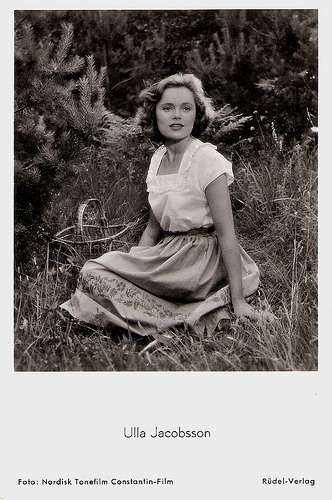
German postcard by Rüdel-Verlag, Hamburg-Bergedorf, no. 548. Photo: Nordisk Tonefilm / Constantin-Film. Publicity still for Hon dansade en sommar/One Summer of Happiness (Arne Mattsson, 1951).
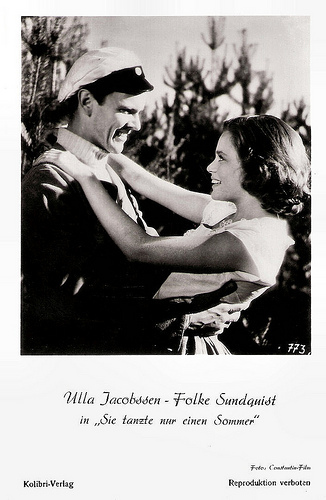
German postcard by Kolibri-Verlag, no. 773. Photo: Constantin-Film. Publicity still for Hon dansade en sommar/One Summer of Happiness (Arne Mattsson, 1951).
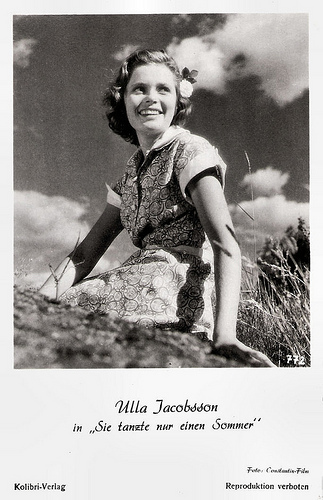
German postcard by Kolibril-Verlag, no. 772. Photo: Constantin-Film. Publicity still for Hon dansade en sommar/One Summer of Happiness (Arne Mattsson, 1951).
She danced for a summer
Hon dansade en sommar (literally: She danced for a summer) tells the story about the 19-years old Göran (Folke Sundquist) who after graduating from high school spends a summer on his uncle Anders's farm. It's summer and there is a lot of work to do at the farm, but the city student isn't accustomed to that.
Göran falls in love with 17 year old Kerstin ( Ulla Jacobsson ), and suddenly he is very engaged in country life. The village youth are in a bitter conflict with the extremely strict vicar (John Elfström), who condemns all their activities as immoral. When the vicar forbids the youth to use the school for their meetings anymore, Anders (Edvin Adolphson) gives them an old barn, which they start renovating.
Kerstin has a strict mother, who in vain forbids her to take part in the youth activities. Kerstin goes there with Göran. She is a bit shy, but the romance between them develops step by step, until it is fulfilled on a summer night, when they swim naked in a lake.
They experience an intense summer together, and Göran dreads the idea of returning to university in the autumn. But a motorcycle accident puts an end to it all, with Kerstin dying in Göran's arms. Göran is accused by the vicar for being a seducer that had led Kerstin astray.
Hon dansade en sommar caused much international controversy, because of the nude swimming sequence and the love scene which included a close-up of Ulla Jacobsson's breasts, but also because of its very anti-clerical message. So, in spite of its awards, the film was banned in several countries, among them Spain, and it wasn't released in the United States until 1955.
Reviewer Max at IMDb : "This charming film should be restored and reissued. Its story line is simple, perhaps a bit trite. However, the central character Kerstin presents us with a rare glimpse of the blossoming of youth, emerging from innocence to passion to tragedy in a short season. No spectacular acting here, but one senses a freshness and spontaneity rarely grasped in low budget productions. No specific message here, other than raw warmth followed by pain and despair."
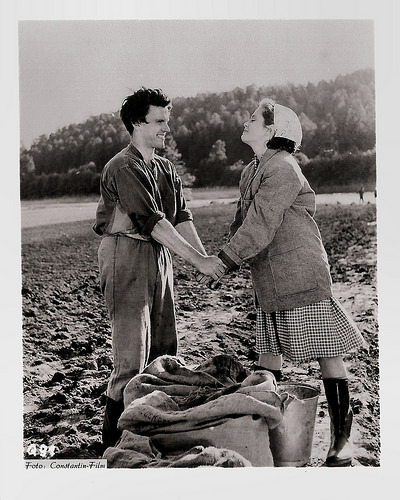
German collectors card. Photo: Constantin-Film. Publicity still for Hon dansade en sommar/One Summer of Happiness (Arne Mattsson, 1951).
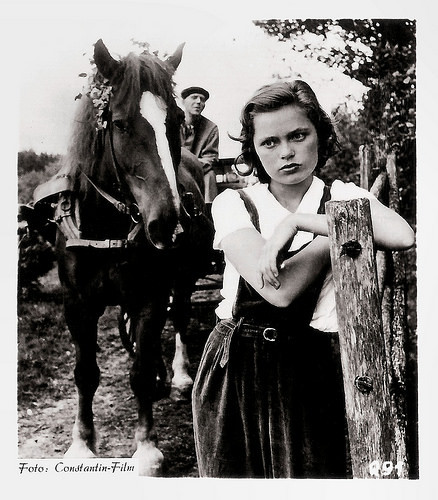
German collectors card. Photo: Constantin-Film. Publicity still for Hon dansade en sommar/One Summer of Happiness (Arne Mattsson, 1951).
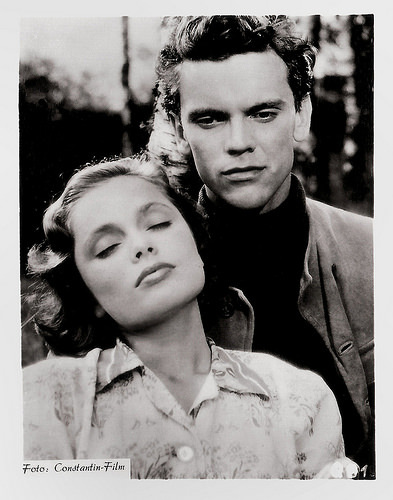
German collectors card. Photo: Constantin-Film. Publicity still for Hon dansade en sommar/One Summer of Happiness (Arne Mattsson, 1951).
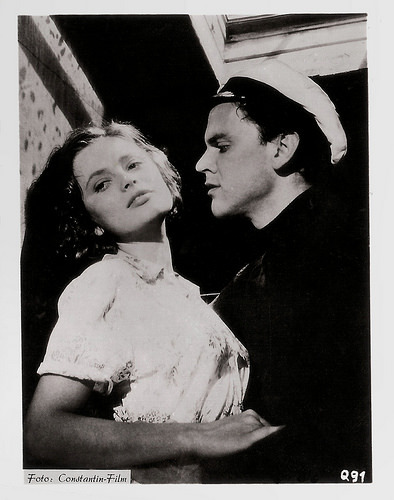
German collectors card. Photo: Constantin-Film. Publicity still for Hon dansade en sommar/One Summer of Happiness (Arne Mattsson, 1951).
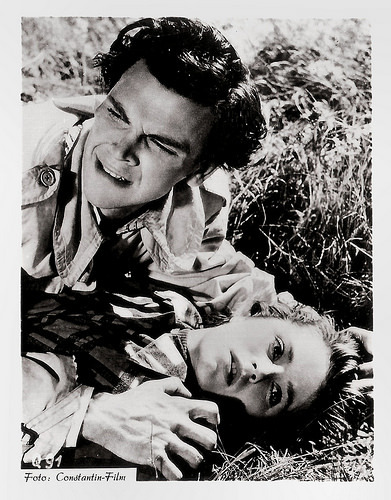
German collectors card. Photo: Constantin-Film. Publicity still for Hon dansade en sommar/One Summer of Happiness (Arne Mattsson, 1951).
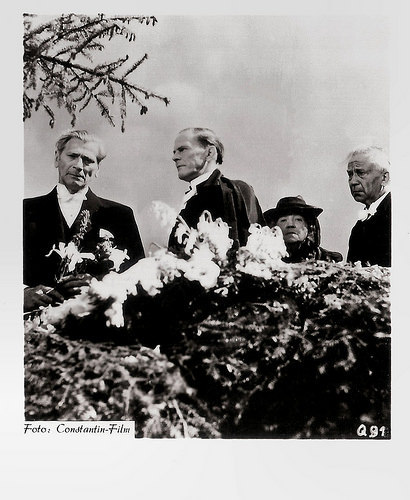
German collectors card. Photo: Constantin-Film. Publicity still for Hon dansade en sommar/One Summer of Happiness (Arne Mattsson, 1951).
Sources: Wikipedia and IMDb.

German postcard by Rüdel-Verlag, Hamburg-Bergedorf, no. 548. Photo: Nordisk Tonefilm / Constantin-Film. Publicity still for Hon dansade en sommar/One Summer of Happiness (Arne Mattsson, 1951).

German postcard by Kolibri-Verlag, no. 773. Photo: Constantin-Film. Publicity still for Hon dansade en sommar/One Summer of Happiness (Arne Mattsson, 1951).

German postcard by Kolibril-Verlag, no. 772. Photo: Constantin-Film. Publicity still for Hon dansade en sommar/One Summer of Happiness (Arne Mattsson, 1951).
She danced for a summer
Hon dansade en sommar (literally: She danced for a summer) tells the story about the 19-years old Göran (Folke Sundquist) who after graduating from high school spends a summer on his uncle Anders's farm. It's summer and there is a lot of work to do at the farm, but the city student isn't accustomed to that.
Göran falls in love with 17 year old Kerstin ( Ulla Jacobsson ), and suddenly he is very engaged in country life. The village youth are in a bitter conflict with the extremely strict vicar (John Elfström), who condemns all their activities as immoral. When the vicar forbids the youth to use the school for their meetings anymore, Anders (Edvin Adolphson) gives them an old barn, which they start renovating.
Kerstin has a strict mother, who in vain forbids her to take part in the youth activities. Kerstin goes there with Göran. She is a bit shy, but the romance between them develops step by step, until it is fulfilled on a summer night, when they swim naked in a lake.
They experience an intense summer together, and Göran dreads the idea of returning to university in the autumn. But a motorcycle accident puts an end to it all, with Kerstin dying in Göran's arms. Göran is accused by the vicar for being a seducer that had led Kerstin astray.
Hon dansade en sommar caused much international controversy, because of the nude swimming sequence and the love scene which included a close-up of Ulla Jacobsson's breasts, but also because of its very anti-clerical message. So, in spite of its awards, the film was banned in several countries, among them Spain, and it wasn't released in the United States until 1955.
Reviewer Max at IMDb : "This charming film should be restored and reissued. Its story line is simple, perhaps a bit trite. However, the central character Kerstin presents us with a rare glimpse of the blossoming of youth, emerging from innocence to passion to tragedy in a short season. No spectacular acting here, but one senses a freshness and spontaneity rarely grasped in low budget productions. No specific message here, other than raw warmth followed by pain and despair."

German collectors card. Photo: Constantin-Film. Publicity still for Hon dansade en sommar/One Summer of Happiness (Arne Mattsson, 1951).

German collectors card. Photo: Constantin-Film. Publicity still for Hon dansade en sommar/One Summer of Happiness (Arne Mattsson, 1951).

German collectors card. Photo: Constantin-Film. Publicity still for Hon dansade en sommar/One Summer of Happiness (Arne Mattsson, 1951).

German collectors card. Photo: Constantin-Film. Publicity still for Hon dansade en sommar/One Summer of Happiness (Arne Mattsson, 1951).

German collectors card. Photo: Constantin-Film. Publicity still for Hon dansade en sommar/One Summer of Happiness (Arne Mattsson, 1951).

German collectors card. Photo: Constantin-Film. Publicity still for Hon dansade en sommar/One Summer of Happiness (Arne Mattsson, 1951).
Sources: Wikipedia and IMDb.
Published on July 26, 2016 22:00
July 25, 2016
Mona Mårtenson
Swedish film actress Mona Mårtenson (1902–1956) appeared in 28 films between 1923 and 1949. With her friend Greta Garbo she had her big breakthrough in the silent masterpiece Gösta Berlings saga (1924). Garbo went to Hollywood and became a legend, but Mårtenson had also an impressive stage and film career in Scandinavia.
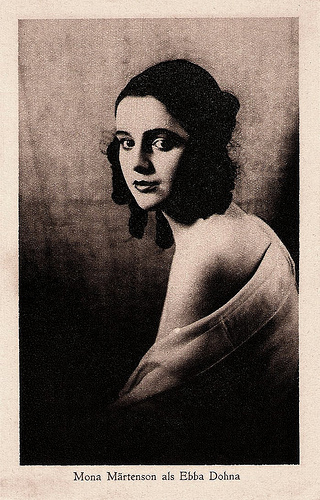
German postcard by Trianon-Film, 1924. Photo: Svenska-Film. Publicity still for Gösta Berlings saga/The Atonement of Gosta Berling (Mauritz Stiller, 1924).
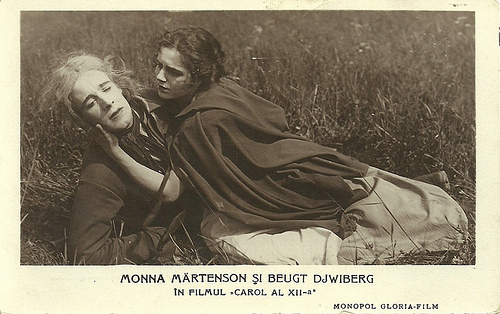
Romanian postcard. Photo: Monopol Gloria Film. Mona Mårtenson (Anna Ulfclou) and Bengt Djurberg (Sven Björnberg) in the Swedish silent film Karl XII (John W. Brunius, 1925), starring Gösta Ekman in the title role.
Lyricism and Vibrancy
Monica Ingeborg Elisabeth ‘Mona’ Mårtenson was born in Stockholm, Sweden in 1902. She grew up in Helsingborg and studied at the Dramatens elevskola (Royal Dramatic Theater Academy).
She made her first film appearance in Anderssonskans Kalle på nya upptåg/Kalle Andersson's New Pranks (Sigurd Wallén, 1923). That same year Mona and her classmate Greta Gustafson (who would change her name into Greta Garbo that same year) were selected by the school to audition for noted Swedish film director Mauritz Stiller.
Both girls got parts in Stiller's upcoming film, the epic romance Gösta Berlings saga/The Atonement of Gosta Berling (Mauritz Stiller, 1924). The film was based on the book by Selma Lagerlöf and features Lars Hanson as the young and attractive minister Gösta Berling. Because Berling has a drinking problem and his preaches are far too daring, he is finally defrocked. Shamed, he is later hired by an unscrupulous and wealthy woman to be a tutor to her beautiful step-daughter (Mona Mårtenson).
At Film Reference , Ronald Bowers writes: “Gösta Berlings Saga is regarded by many as Sweden's Gone With the Wind. With an epic sweep, episodic structure, and numerous characters, it evokes 19th-century Swedish life and is imbued with a lyricism and vibrancy which places its director Mauritz Stiller among the masters of silent film. The film represents both the pinnacle and the swan song of the ‘golden age’ of Swedish cinema: 1913 - 1924. With its plot centering on the search for redemption by Gösta Berling, the defrocked priest, and the several women who disastrously fall in love with him, it numbers, along with D.W. Griffith's Intolerance, among the earliest important films of social protest and one of the masterpieces of silent cinema."
After the huge success of the film Mårtenson did not leave Sweden for Hollywood like her director and co-stars although, as the site Moviediva suggests, Louis B. Mayer also offered her a contract. Mårtenson stayed in Stockholm and went to work for Dramaten, the Royal Dramatic Theater in Stockholm.
She also appeared in such films as Skeppargatan 40/Skeppar Gate 40 (Gustaf Edgren, 1925) with Einar Hanson , the two-part Karl XII (John W. Brunius, 1925) featuring Gösta Ekman , and Ingmarsarvet/The Ingmar Inheritance (Gustav Molander, 1925) with Conrad Veidt .
Gustav Molander directed Lars Hanson and her in another Selma Lagerlöf adaptation Till österland/To the Orient (Gustav Molander, 1926), filmed in Jaffa, Israel. She starred again for Molander in Förseglade läppar/Sealed lips (Gustaf Molander, 1927), co-starring Fred Louis Lerch and Sandra Milowanoff , and based on a story by Guy de Maupausant. The film was a huge success in Sweden. Initially the French actress Geneviève Cargese would play the main role, but she fell ill in Stockholm and was replaced by Mona Mårtenson.
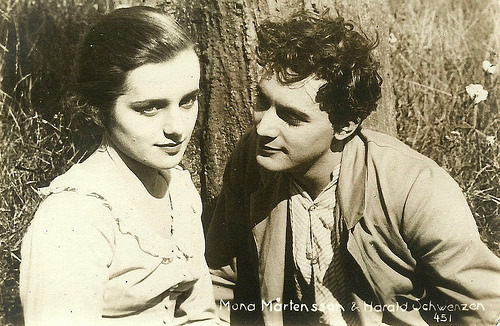
Danish postcard by Helsingin, Helsingfors, no. 451. Photo: Mona Märtenson and Harald Schwenzen in what could be the film Till österland (Gustav Molander, 1926).

Finnish postcard by Kerttikeskus Kortcentralen, Helsinki, no. 1311. Photo: publicity still for the Swedish silent film Laila (George Schnéevoigt 1929), starring Mona Mårtenson.
Pure Joie de Vivre
In Germany Mona Mårtenson starred in Die Frau im Talar/The Woman in the Robe (Adolf Trotz, 1929) with Aud Egede Nissen and Paul Richter .
In Norway she appeared in the romantic melodrama Laila (1929), directed by Danish-German filmmaker and noted cinematographer George Schnéevoigt. Martenson featured as Laila, a young girl separated from her parents as a baby and raised by a wealthy reindeer owner Aslag (Peter Malberg) in the frozen tundra of Scandinavia. Though she is returned a year later, Laila grows into a young woman of two worlds, at home with both her settled and nomadic upbringings. Laila soon finds herself in a love triangle with her foster brother Mellet (Henry Gleditsch) and her cousin Anders (Harald Schwenzen), played out against the backdrop of an encroaching plague.
For years Laila was rarely seen, but in 2006, it was digitally restored by the Norwegian Film institute and in 2011 it was released on DVD by Flicker Alley. At IMDb , reviewer Hyzenthlay_and_me writes about Laila: “She is played by Mona Mårtenson, who is a wonder to behold. The movie is a drama of faces, there is a number of hugely expressive faces in the film, and all you can do is sit there and take in their radiance and pure joie de vivre. Mona for example really is a damned livewire, it's all she can do to stop bursting out of her skin, happiness is written all over her face. With silent film it really does help if you have expressive actors, and they hit the jackpot of them with this movie.”
Schnéevoigt also directed her in Eskimo (George Schnéevoigt, 1930) with Paul Richter . In 1930 she left the theatre company of Dramaten and moved to Gösta Ekman and his Lorensbergsteatern in Göteborg. She would later return to Dramaten.
Mårtenson continued her film career smoothly into the sound era. In the Danish comedy I kantonnement/In the cantonment (Lau Lauritzen, 1932) she starred opposite the comic duo Fy og Bi (Carl Schenstrøm and Harald Madsen; also known as Pat & Patachon or Long & Short).
Other sound films in which she starred are I nöd och lust/In Sickness and Health (Ivar Johansson, 1938) and the drama Västkustens hjältar/West Coast heroes (Lau Lauritzen, Alice O'Fredericks, 1940) now as the mother of the hero, played by Fritiof Billquist. In the following years she played only small roles in Scandinavian films.
Her last film was Pippi Långstrump/Pippi Longstocking (Per Gunvall, 1949), the first film adaptation of Astrid Lindgren’s classic children’s novel, only four years after the book was published in Sweden. Pippi was played by the 26-year old Viveca Serlachius (the eldest Pippi-actress ever) and Mårtenson played a supporting role as Pia.
Mona Mårtenson died in 1956 in Stockholm, aged 54.
Scene from Gösta Berlings saga/The Atonement of Gosta Berling (1924). Source: Kino International (You Tube).
Scene from Laila (1929). Source: Flickr Alley (YouTube).
Sources: Ronald Bowers (Film Reference), Hal Erickson (AllMovie), Phillip Oliver (Greta Garbo – The Ultimate Star), Moviediva, Wikipedia (English and Swedish) and .

German postcard by Trianon-Film, 1924. Photo: Svenska-Film. Publicity still for Gösta Berlings saga/The Atonement of Gosta Berling (Mauritz Stiller, 1924).

Romanian postcard. Photo: Monopol Gloria Film. Mona Mårtenson (Anna Ulfclou) and Bengt Djurberg (Sven Björnberg) in the Swedish silent film Karl XII (John W. Brunius, 1925), starring Gösta Ekman in the title role.
Lyricism and Vibrancy
Monica Ingeborg Elisabeth ‘Mona’ Mårtenson was born in Stockholm, Sweden in 1902. She grew up in Helsingborg and studied at the Dramatens elevskola (Royal Dramatic Theater Academy).
She made her first film appearance in Anderssonskans Kalle på nya upptåg/Kalle Andersson's New Pranks (Sigurd Wallén, 1923). That same year Mona and her classmate Greta Gustafson (who would change her name into Greta Garbo that same year) were selected by the school to audition for noted Swedish film director Mauritz Stiller.
Both girls got parts in Stiller's upcoming film, the epic romance Gösta Berlings saga/The Atonement of Gosta Berling (Mauritz Stiller, 1924). The film was based on the book by Selma Lagerlöf and features Lars Hanson as the young and attractive minister Gösta Berling. Because Berling has a drinking problem and his preaches are far too daring, he is finally defrocked. Shamed, he is later hired by an unscrupulous and wealthy woman to be a tutor to her beautiful step-daughter (Mona Mårtenson).
At Film Reference , Ronald Bowers writes: “Gösta Berlings Saga is regarded by many as Sweden's Gone With the Wind. With an epic sweep, episodic structure, and numerous characters, it evokes 19th-century Swedish life and is imbued with a lyricism and vibrancy which places its director Mauritz Stiller among the masters of silent film. The film represents both the pinnacle and the swan song of the ‘golden age’ of Swedish cinema: 1913 - 1924. With its plot centering on the search for redemption by Gösta Berling, the defrocked priest, and the several women who disastrously fall in love with him, it numbers, along with D.W. Griffith's Intolerance, among the earliest important films of social protest and one of the masterpieces of silent cinema."
After the huge success of the film Mårtenson did not leave Sweden for Hollywood like her director and co-stars although, as the site Moviediva suggests, Louis B. Mayer also offered her a contract. Mårtenson stayed in Stockholm and went to work for Dramaten, the Royal Dramatic Theater in Stockholm.
She also appeared in such films as Skeppargatan 40/Skeppar Gate 40 (Gustaf Edgren, 1925) with Einar Hanson , the two-part Karl XII (John W. Brunius, 1925) featuring Gösta Ekman , and Ingmarsarvet/The Ingmar Inheritance (Gustav Molander, 1925) with Conrad Veidt .
Gustav Molander directed Lars Hanson and her in another Selma Lagerlöf adaptation Till österland/To the Orient (Gustav Molander, 1926), filmed in Jaffa, Israel. She starred again for Molander in Förseglade läppar/Sealed lips (Gustaf Molander, 1927), co-starring Fred Louis Lerch and Sandra Milowanoff , and based on a story by Guy de Maupausant. The film was a huge success in Sweden. Initially the French actress Geneviève Cargese would play the main role, but she fell ill in Stockholm and was replaced by Mona Mårtenson.

Danish postcard by Helsingin, Helsingfors, no. 451. Photo: Mona Märtenson and Harald Schwenzen in what could be the film Till österland (Gustav Molander, 1926).

Finnish postcard by Kerttikeskus Kortcentralen, Helsinki, no. 1311. Photo: publicity still for the Swedish silent film Laila (George Schnéevoigt 1929), starring Mona Mårtenson.
Pure Joie de Vivre
In Germany Mona Mårtenson starred in Die Frau im Talar/The Woman in the Robe (Adolf Trotz, 1929) with Aud Egede Nissen and Paul Richter .
In Norway she appeared in the romantic melodrama Laila (1929), directed by Danish-German filmmaker and noted cinematographer George Schnéevoigt. Martenson featured as Laila, a young girl separated from her parents as a baby and raised by a wealthy reindeer owner Aslag (Peter Malberg) in the frozen tundra of Scandinavia. Though she is returned a year later, Laila grows into a young woman of two worlds, at home with both her settled and nomadic upbringings. Laila soon finds herself in a love triangle with her foster brother Mellet (Henry Gleditsch) and her cousin Anders (Harald Schwenzen), played out against the backdrop of an encroaching plague.
For years Laila was rarely seen, but in 2006, it was digitally restored by the Norwegian Film institute and in 2011 it was released on DVD by Flicker Alley. At IMDb , reviewer Hyzenthlay_and_me writes about Laila: “She is played by Mona Mårtenson, who is a wonder to behold. The movie is a drama of faces, there is a number of hugely expressive faces in the film, and all you can do is sit there and take in their radiance and pure joie de vivre. Mona for example really is a damned livewire, it's all she can do to stop bursting out of her skin, happiness is written all over her face. With silent film it really does help if you have expressive actors, and they hit the jackpot of them with this movie.”
Schnéevoigt also directed her in Eskimo (George Schnéevoigt, 1930) with Paul Richter . In 1930 she left the theatre company of Dramaten and moved to Gösta Ekman and his Lorensbergsteatern in Göteborg. She would later return to Dramaten.
Mårtenson continued her film career smoothly into the sound era. In the Danish comedy I kantonnement/In the cantonment (Lau Lauritzen, 1932) she starred opposite the comic duo Fy og Bi (Carl Schenstrøm and Harald Madsen; also known as Pat & Patachon or Long & Short).
Other sound films in which she starred are I nöd och lust/In Sickness and Health (Ivar Johansson, 1938) and the drama Västkustens hjältar/West Coast heroes (Lau Lauritzen, Alice O'Fredericks, 1940) now as the mother of the hero, played by Fritiof Billquist. In the following years she played only small roles in Scandinavian films.
Her last film was Pippi Långstrump/Pippi Longstocking (Per Gunvall, 1949), the first film adaptation of Astrid Lindgren’s classic children’s novel, only four years after the book was published in Sweden. Pippi was played by the 26-year old Viveca Serlachius (the eldest Pippi-actress ever) and Mårtenson played a supporting role as Pia.
Mona Mårtenson died in 1956 in Stockholm, aged 54.
Scene from Gösta Berlings saga/The Atonement of Gosta Berling (1924). Source: Kino International (You Tube).
Scene from Laila (1929). Source: Flickr Alley (YouTube).
Sources: Ronald Bowers (Film Reference), Hal Erickson (AllMovie), Phillip Oliver (Greta Garbo – The Ultimate Star), Moviediva, Wikipedia (English and Swedish) and .
Published on July 25, 2016 22:00
July 24, 2016
Cilly Feindt
The tiny, dainty blonde Cilly Feindt (1909-1999) was a German star of the circus ring. In her heyday, she was regarded as one of the finest haute école horse riders of her time. She alternated in the 1920s and 1930s between circus and the cinema.
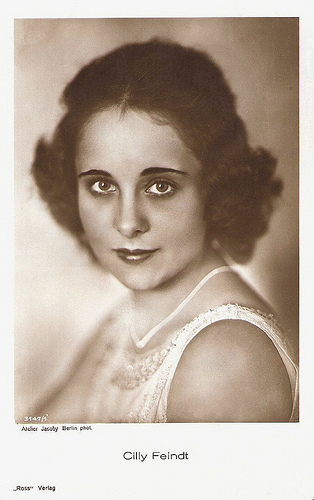
German postcard by Ross Verlag, Berlin, no. 3147/1, 1928-1929. Photo: Atelier Jacoby, Berlin.
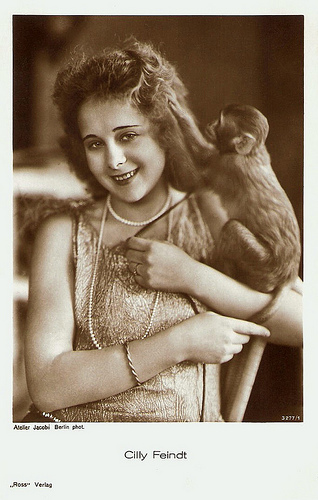
German postcard by Ross Verlag, Berlin, no. 3277/1, 1928-1929. Photo: Atelier Jacobi, Berlin.
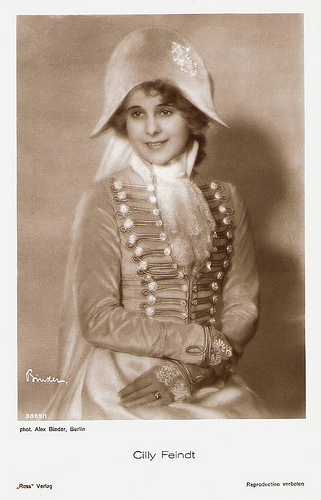
German postcard by Ross Verlag, Berlin, no. 3869/1, 1928-1929. Photo: Alex Binder, Berlin.
The Greatest Lady School Rider of All Time
Cilly Feindt was born in Berlin, Germany in 1909. She was the daughter of film distributor and producer Wilhelm Feindt. Her father would later produce her first films.
When Cilly was nine she became interested in horses and receives an equestrian training. At 14, she started at the circus Paul Busch. With her horse Nestor, she performed as a high-school rider and she became very popular. Later Cilly appeared at the Variété Wintergarten and the Scala theatre in Berlin.
Soon she was spotted for the film. Cilly made her film début in Die Zirkusprinzessin/The Circus Princess (Adolf Gärtner, 1925), based on an operetta by Emmerich Kálmán. The film was produced by her father.
Other films of the silent era were Der Feldmarschall/The Field Marshall (Romano Mengon, 1927), Ein Mordsmädel/A Knock-off Gal (Sidney Morgan, 1927) with Werner Pittschau , and again in a new version of Die Zirkusprinzessin/The Circus Princess (Victor Janson, 1929) with Trude Berliner . In all these films she played high-school riders and performed with her horse Nestor.
In the following years she alternated between circus and cinema. The British Bertram Mills was so impressed by her abilities that he brought her to the Olympia in London, for his circus in the winter of 1931-1932, billing her as 'The Greatest Lady School Rider of all time'.
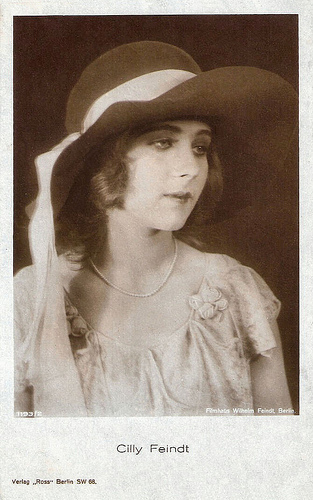
German postcard by Ross Verlag, Berlin, no. 1193/2, 1927-1928. Photo: Filmhaus Wilhelm Feindt, Berlin.
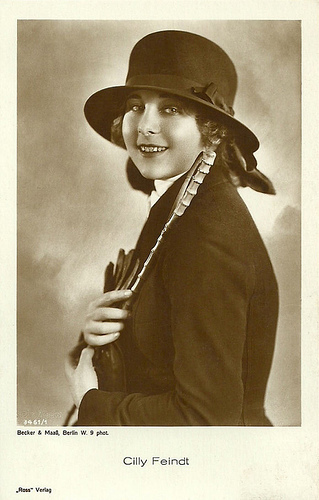
German postcard by Ross Verlag, no. 1961/1, 1927-1928. Photo: Becker & Maass, Berlin.
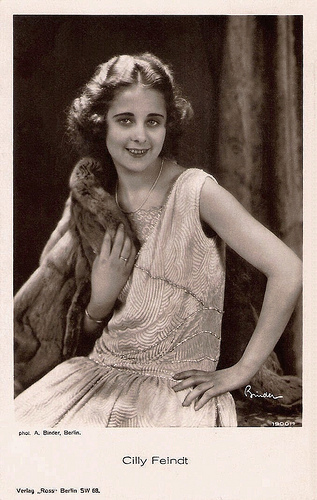
German postcard by Ross Verlag, Berlin, no. 1900/1, 1927-1928. Photo: Alex Binder, Berlin.
Lady Godiva
During a successful tour through South America Cilly Feindt conquers Montevideo, Buenos Aires and Rio de Janeiro.
Back in Germany she continued her film career with the light comedies Ferien vom Ich/Holiday from Myself (Hans Deppe, 1934) with Carola Höhn , and Leichte Kavallerie/Light Cavalry (Werner Hochbaum, 1935) starring Marika Rökk .
Hereafter followed a tour through the half of Europe and the US. The Second World War meant a temporary halt to her career.
After the war she was signed on by Circus Althoff and in 1948 she got an offer from the Ringling Brothers circus in the US. With this circus she went on tour till 1951 and appeared in the United States and Canada.
When her engagement ended she settled in California and devoted herself to her horses. Furthermore she appeared in small, uncredited parts in Gigi (Vincente Minnelli) with Maurice Chevalier and Leslie Caron and as well as Lady Godiva in Two Weeks in Another Town (Vincente Minnelli, 1962) with Kirk Douglas.
Cilly Feindt died in 1999, in Los Angeles, US. She was 90. For a while she had a relationship with boxer Max Schmeling.
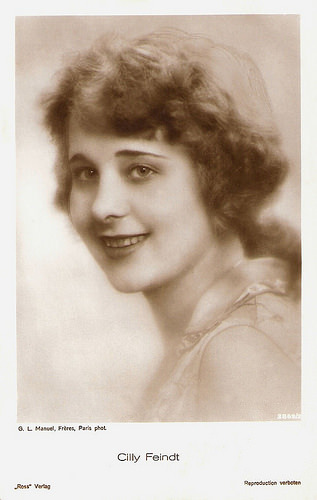
German postcard by Ross Verlag, Berlin, no. 3869/2, 1928-1929. Photo: Manuel Frères, Paris.
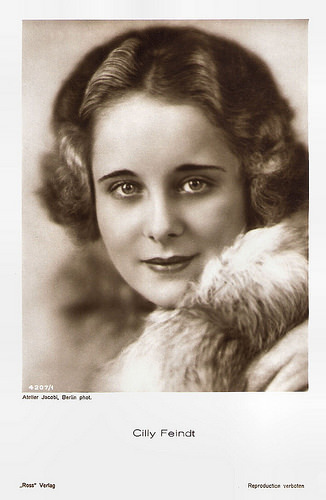
German postcard by Ross Verlag, Berlin, no. 4207/1, 1929-1930. Photo: Atelier Jacobi, Berlin.
Commercial Schnellgang for Graham Paige. Source: ChrMiltenberger (YouTube). Music for Piano, Organ, Celesta, Mallet by Christopher Miltenberger.
Sources: Thomas Staedeli (Cyranos), D. Nevil (The Independent), Film-Zeit.de (German), and Wikipedia.

German postcard by Ross Verlag, Berlin, no. 3147/1, 1928-1929. Photo: Atelier Jacoby, Berlin.

German postcard by Ross Verlag, Berlin, no. 3277/1, 1928-1929. Photo: Atelier Jacobi, Berlin.

German postcard by Ross Verlag, Berlin, no. 3869/1, 1928-1929. Photo: Alex Binder, Berlin.
The Greatest Lady School Rider of All Time
Cilly Feindt was born in Berlin, Germany in 1909. She was the daughter of film distributor and producer Wilhelm Feindt. Her father would later produce her first films.
When Cilly was nine she became interested in horses and receives an equestrian training. At 14, she started at the circus Paul Busch. With her horse Nestor, she performed as a high-school rider and she became very popular. Later Cilly appeared at the Variété Wintergarten and the Scala theatre in Berlin.
Soon she was spotted for the film. Cilly made her film début in Die Zirkusprinzessin/The Circus Princess (Adolf Gärtner, 1925), based on an operetta by Emmerich Kálmán. The film was produced by her father.
Other films of the silent era were Der Feldmarschall/The Field Marshall (Romano Mengon, 1927), Ein Mordsmädel/A Knock-off Gal (Sidney Morgan, 1927) with Werner Pittschau , and again in a new version of Die Zirkusprinzessin/The Circus Princess (Victor Janson, 1929) with Trude Berliner . In all these films she played high-school riders and performed with her horse Nestor.
In the following years she alternated between circus and cinema. The British Bertram Mills was so impressed by her abilities that he brought her to the Olympia in London, for his circus in the winter of 1931-1932, billing her as 'The Greatest Lady School Rider of all time'.

German postcard by Ross Verlag, Berlin, no. 1193/2, 1927-1928. Photo: Filmhaus Wilhelm Feindt, Berlin.

German postcard by Ross Verlag, no. 1961/1, 1927-1928. Photo: Becker & Maass, Berlin.

German postcard by Ross Verlag, Berlin, no. 1900/1, 1927-1928. Photo: Alex Binder, Berlin.
Lady Godiva
During a successful tour through South America Cilly Feindt conquers Montevideo, Buenos Aires and Rio de Janeiro.
Back in Germany she continued her film career with the light comedies Ferien vom Ich/Holiday from Myself (Hans Deppe, 1934) with Carola Höhn , and Leichte Kavallerie/Light Cavalry (Werner Hochbaum, 1935) starring Marika Rökk .
Hereafter followed a tour through the half of Europe and the US. The Second World War meant a temporary halt to her career.
After the war she was signed on by Circus Althoff and in 1948 she got an offer from the Ringling Brothers circus in the US. With this circus she went on tour till 1951 and appeared in the United States and Canada.
When her engagement ended she settled in California and devoted herself to her horses. Furthermore she appeared in small, uncredited parts in Gigi (Vincente Minnelli) with Maurice Chevalier and Leslie Caron and as well as Lady Godiva in Two Weeks in Another Town (Vincente Minnelli, 1962) with Kirk Douglas.
Cilly Feindt died in 1999, in Los Angeles, US. She was 90. For a while she had a relationship with boxer Max Schmeling.

German postcard by Ross Verlag, Berlin, no. 3869/2, 1928-1929. Photo: Manuel Frères, Paris.

German postcard by Ross Verlag, Berlin, no. 4207/1, 1929-1930. Photo: Atelier Jacobi, Berlin.
Commercial Schnellgang for Graham Paige. Source: ChrMiltenberger (YouTube). Music for Piano, Organ, Celesta, Mallet by Christopher Miltenberger.
Sources: Thomas Staedeli (Cyranos), D. Nevil (The Independent), Film-Zeit.de (German), and Wikipedia.
Published on July 24, 2016 22:00
July 23, 2016
Albert Lambert
Albert Lambert (1865-1941), a.k.a. Albert Lambert fils, was a French stage and screen actor, who was for a long time part of the Comédie-Française. He also played in several early French film d’art films, first of all L'Assassinat du duc de Guise (1908).
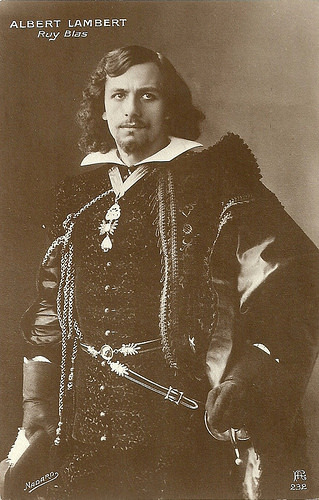
French postcard. Photo: Nadar, no. 232. The photo dates from the 1880s, but the card may be a bit newer.
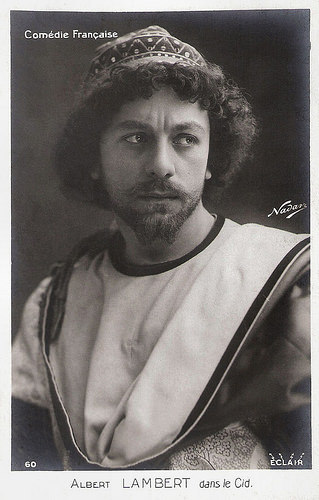
French postcard by Eclair, no. 60. Photo: Nadar. Publicity still for the Comédie Française stage production of Le Cid (1906) by Pierre Corneille.
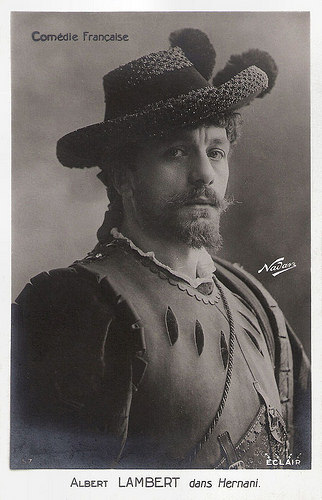
French postcard by Eclair, no. 57. Photo: Nadar. Publicity still for the Comédie Française stage production of Hernani (1920?) by Victor Hugo.
The respectable Film d'Art
Albert-Raphaël Lambert was born in Rouen in 1865 as son of the actor and sculptor Albert Lambert. Junior did the Conservatoire national, where in 1883 he obtained a first award in tragedy. Lambert’s father for a long time was Pensionnaire at the Théâtre de l'Odéon in Paris. In the 1880s Lambert fils already acted at the Théâtre de l'Odéon in plays by e.g. François Coppée, Alphonse Daudet and William Shakespeare before entering the reputed Comédie-Française in 1885 with his part in Ruy Blas by Victor Hugo.
Lambert became sociétaire of the Comédie-Française in 1891, which he remained till 1935. At the famous stage company, his roles of Antioch (1893) in Bérénice by Jean Racine and Didier (1905) in Marion Delorme by Victor Hugo became so popular, that he repeated them in later years (resp. 1906 and 1922). While Lambert acted in many plays by Hugo, he also was a regular in plays by Shakespeare, Sophocles and Racine.
In 1930 he became doyen at the Comédie-Française and sociétaire honoraire in 1936. In 1934 he also performed at the London Cambridge Theatre in the lead of Hugo's Ruy Blas (1934), as Alcestis in Molière's Le misanthrope/The Misanthrope (1934), and as Rodrigue in Corneille's Le cid (1934).
Lambert was also one of the first actors to help launch the new film genre of the French Film d’art films. In order to raise the reputation of the new medium of cinema, reputed stage actors were attracted to act in cinematic adaptations of famous novels and stage plays, or reenactments of famous historical events.
Lambert played the lead of the Duc de Guise in the first of these films, L'Assassinat du duc de Guise/The Assassination of the Duke de Guise (1908), directed by André Calmettes and Charles Le Bargy , and scripted by Henry Lavedan. The film recounts a famous historical episode, the day of 23 December 1588, during which Henry I of Lorraine, Duke of Guise, rival of King Henry III ( Charles Le Bargy ), was summoned by the latter to his castle in Blois, despite the pleas of Marquise Noirmoutier, his mistress ( Gabrielle Robinne ), not to go. De Guise was stabbed to death by the guards of the royal army at the castle of Blois.
Everything was done to present the film L'Assassinat du duc de Guise/he Assassination of the Duke de Guise (1908) as artistic and respectable as possible, quoting famous historical paintings such as Paul Delaroche’s Assassinat du Duc de Guise (1834) but also having a purposely written score - probably the first in film history - by the famous composer Camille Saint-Saëns.
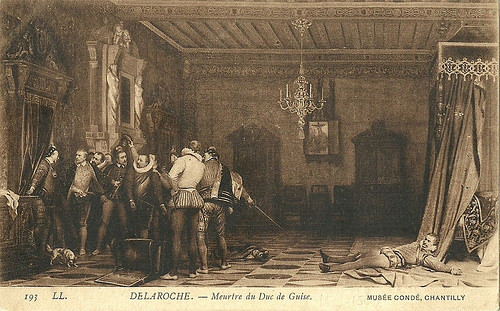
French postcard by Union postale universelle. Early 20th century reproduction of Paul Delaroche's painting L'Assassinat du Duc de Guise (1834) at the Musée Condé, Chantilly. Quoted in the 1908 French silent film L'Assassinat du Duc de Guise by André Calmettes and Charles Le Bargy.
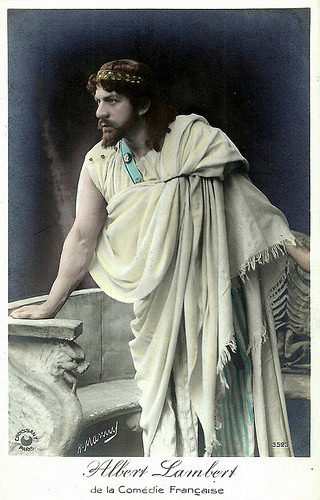
French postcard by Croissant, Paris, no. 3523. Photo: H. Manuel [?]. Albert Lambert as Orestes.
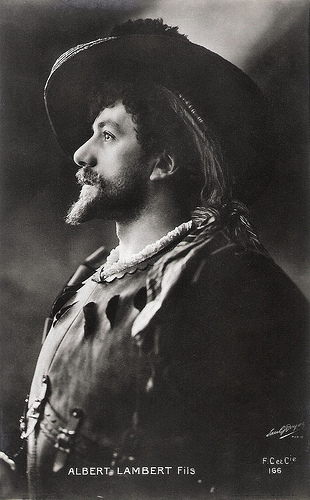
French postcard by F.C. et Cie, no. 166. Photo: Paul Boyer, Paris. Albert Lambert as Hernani.
Charles Pathé
The reception of L'Assassinat du duc de Guise/The Assassination of the Duke de Guise, which premiered 17 November 1908 in Paris, was so favourable, that the newly founded film company Le Film d’Art was backed by film magnate Charles Pathé to produce a whole range of such Film d’art films, though not all had the same success.
Lambert thus acted as Antinous opposite Paul Mounet as Ulysses and Julia Bartet (other sources erroneously indicate Régina Badet) as Penelope in Le retour d’Ulysse (André Calmettes, Charles Le Bargy, 1909), and as Christ opposite Jean Mounet-Sully as Judas in Le baiser de Judas (Armand Bour, André Calmettes, 1909).
After that followed parts in Pygmalion (Daniel Riche, 1910), Oedipe roi (André Calmettes, 1910) after Sophocles and with Mounet-Sully and Berthe Bovy co-acting, Aux temps des premiers chrétiens (André Calmettes, 1910) a liberal adaptation of Sienkiewicz’s Quo vadis? with Lambert as Marcus Vinicius, and Roi d’un jour (André Calmettes, 1910) on the revolution of Masaniello (Lambert) in 17th century Naples against the Duke of Argos (Henri Étievant). IMDb also mentions Moderne Galathée (Georges Denola, 1911) and Chaines rompues (Henri Pouctal, 1912).
Lambert’s film career was short, but his Duc de Guise became film history. While not in Paris, Albert Lambert lived in La Bouille, near Rouen, where he had an eclectic, Neo-Gothic mansion, Le Nids, bought and restyled by his father in 1892.
Albert Lambert was married five times, e.g. with Odette-Jeanne Lévi, with whom he had a daughter Jacqueline Van Tieghem. Lambert died in 1941 in Paris at the age of 76 years.
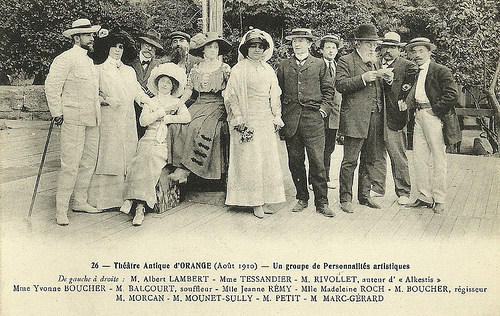
French postcard, no. 26. Théâtre Antique d'Orange, August 1910. Group of artistic personalities. Left to right: Albert Lambert, Aimée Tessandier, Georges Rivollet (auteur of Alkestis, 1899), Yvonne Boucher, Balcourt (souffleur), Jeanne Rémy, Madeleine Roch, Boucher (director), Morcan, Jean Mounet-Sully, Petit, Marc Gérard. Alkestis by Euripides was reworked by Rivollet. Lambert had played the lead of Herakles in Alkestis already in 1900 in Paris, while Paul Mounet, Mounet-Sully's elder brother had played it at its premiere in 1899 at the Theatre d'Orange.
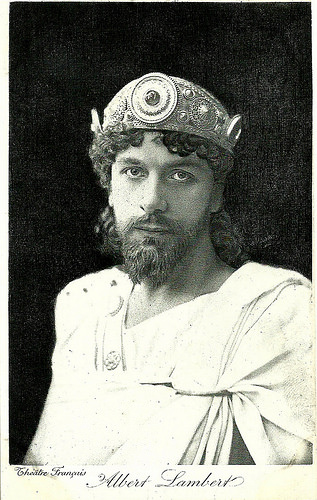
French postcard. Photo: Taille-Douce.
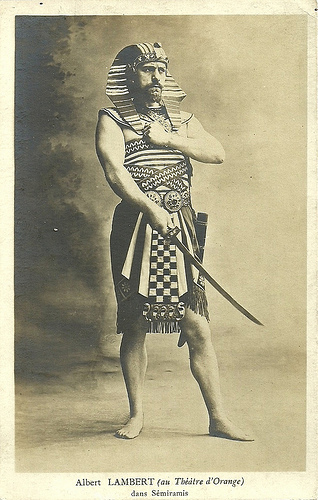
French postcard. Albert Lambert as the Egyptian prince Keth-Aour in the play Sémiramis by Josephin Peladan at the Théâtre Antique d'Orange.
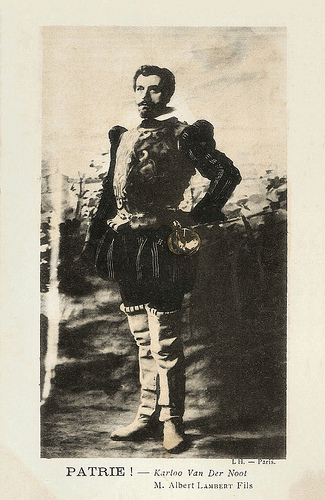
French postcard. Photo: L.H., Paris. Publicity still for the stage production of Patrie! by Victorien Sardou, performed in Paris in 1901 at the Comédie Française, with Albert Lambert Fils as Karloo Van Der Noot.
Sources: Wikipedia (French), , Filmographie Fondation Jerome Seydoux Pathe, 1895 Revues, Mounet Sully et Paul Mounet.

French postcard. Photo: Nadar, no. 232. The photo dates from the 1880s, but the card may be a bit newer.

French postcard by Eclair, no. 60. Photo: Nadar. Publicity still for the Comédie Française stage production of Le Cid (1906) by Pierre Corneille.

French postcard by Eclair, no. 57. Photo: Nadar. Publicity still for the Comédie Française stage production of Hernani (1920?) by Victor Hugo.
The respectable Film d'Art
Albert-Raphaël Lambert was born in Rouen in 1865 as son of the actor and sculptor Albert Lambert. Junior did the Conservatoire national, where in 1883 he obtained a first award in tragedy. Lambert’s father for a long time was Pensionnaire at the Théâtre de l'Odéon in Paris. In the 1880s Lambert fils already acted at the Théâtre de l'Odéon in plays by e.g. François Coppée, Alphonse Daudet and William Shakespeare before entering the reputed Comédie-Française in 1885 with his part in Ruy Blas by Victor Hugo.
Lambert became sociétaire of the Comédie-Française in 1891, which he remained till 1935. At the famous stage company, his roles of Antioch (1893) in Bérénice by Jean Racine and Didier (1905) in Marion Delorme by Victor Hugo became so popular, that he repeated them in later years (resp. 1906 and 1922). While Lambert acted in many plays by Hugo, he also was a regular in plays by Shakespeare, Sophocles and Racine.
In 1930 he became doyen at the Comédie-Française and sociétaire honoraire in 1936. In 1934 he also performed at the London Cambridge Theatre in the lead of Hugo's Ruy Blas (1934), as Alcestis in Molière's Le misanthrope/The Misanthrope (1934), and as Rodrigue in Corneille's Le cid (1934).
Lambert was also one of the first actors to help launch the new film genre of the French Film d’art films. In order to raise the reputation of the new medium of cinema, reputed stage actors were attracted to act in cinematic adaptations of famous novels and stage plays, or reenactments of famous historical events.
Lambert played the lead of the Duc de Guise in the first of these films, L'Assassinat du duc de Guise/The Assassination of the Duke de Guise (1908), directed by André Calmettes and Charles Le Bargy , and scripted by Henry Lavedan. The film recounts a famous historical episode, the day of 23 December 1588, during which Henry I of Lorraine, Duke of Guise, rival of King Henry III ( Charles Le Bargy ), was summoned by the latter to his castle in Blois, despite the pleas of Marquise Noirmoutier, his mistress ( Gabrielle Robinne ), not to go. De Guise was stabbed to death by the guards of the royal army at the castle of Blois.
Everything was done to present the film L'Assassinat du duc de Guise/he Assassination of the Duke de Guise (1908) as artistic and respectable as possible, quoting famous historical paintings such as Paul Delaroche’s Assassinat du Duc de Guise (1834) but also having a purposely written score - probably the first in film history - by the famous composer Camille Saint-Saëns.

French postcard by Union postale universelle. Early 20th century reproduction of Paul Delaroche's painting L'Assassinat du Duc de Guise (1834) at the Musée Condé, Chantilly. Quoted in the 1908 French silent film L'Assassinat du Duc de Guise by André Calmettes and Charles Le Bargy.

French postcard by Croissant, Paris, no. 3523. Photo: H. Manuel [?]. Albert Lambert as Orestes.

French postcard by F.C. et Cie, no. 166. Photo: Paul Boyer, Paris. Albert Lambert as Hernani.
Charles Pathé
The reception of L'Assassinat du duc de Guise/The Assassination of the Duke de Guise, which premiered 17 November 1908 in Paris, was so favourable, that the newly founded film company Le Film d’Art was backed by film magnate Charles Pathé to produce a whole range of such Film d’art films, though not all had the same success.
Lambert thus acted as Antinous opposite Paul Mounet as Ulysses and Julia Bartet (other sources erroneously indicate Régina Badet) as Penelope in Le retour d’Ulysse (André Calmettes, Charles Le Bargy, 1909), and as Christ opposite Jean Mounet-Sully as Judas in Le baiser de Judas (Armand Bour, André Calmettes, 1909).
After that followed parts in Pygmalion (Daniel Riche, 1910), Oedipe roi (André Calmettes, 1910) after Sophocles and with Mounet-Sully and Berthe Bovy co-acting, Aux temps des premiers chrétiens (André Calmettes, 1910) a liberal adaptation of Sienkiewicz’s Quo vadis? with Lambert as Marcus Vinicius, and Roi d’un jour (André Calmettes, 1910) on the revolution of Masaniello (Lambert) in 17th century Naples against the Duke of Argos (Henri Étievant). IMDb also mentions Moderne Galathée (Georges Denola, 1911) and Chaines rompues (Henri Pouctal, 1912).
Lambert’s film career was short, but his Duc de Guise became film history. While not in Paris, Albert Lambert lived in La Bouille, near Rouen, where he had an eclectic, Neo-Gothic mansion, Le Nids, bought and restyled by his father in 1892.
Albert Lambert was married five times, e.g. with Odette-Jeanne Lévi, with whom he had a daughter Jacqueline Van Tieghem. Lambert died in 1941 in Paris at the age of 76 years.

French postcard, no. 26. Théâtre Antique d'Orange, August 1910. Group of artistic personalities. Left to right: Albert Lambert, Aimée Tessandier, Georges Rivollet (auteur of Alkestis, 1899), Yvonne Boucher, Balcourt (souffleur), Jeanne Rémy, Madeleine Roch, Boucher (director), Morcan, Jean Mounet-Sully, Petit, Marc Gérard. Alkestis by Euripides was reworked by Rivollet. Lambert had played the lead of Herakles in Alkestis already in 1900 in Paris, while Paul Mounet, Mounet-Sully's elder brother had played it at its premiere in 1899 at the Theatre d'Orange.

French postcard. Photo: Taille-Douce.

French postcard. Albert Lambert as the Egyptian prince Keth-Aour in the play Sémiramis by Josephin Peladan at the Théâtre Antique d'Orange.

French postcard. Photo: L.H., Paris. Publicity still for the stage production of Patrie! by Victorien Sardou, performed in Paris in 1901 at the Comédie Française, with Albert Lambert Fils as Karloo Van Der Noot.
Sources: Wikipedia (French), , Filmographie Fondation Jerome Seydoux Pathe, 1895 Revues, Mounet Sully et Paul Mounet.
Published on July 23, 2016 22:00
Paul van Yperen's Blog
- Paul van Yperen's profile
- 13 followers
Paul van Yperen isn't a Goodreads Author
(yet),
but they
do have a blog,
so here are some recent posts imported from
their feed.



